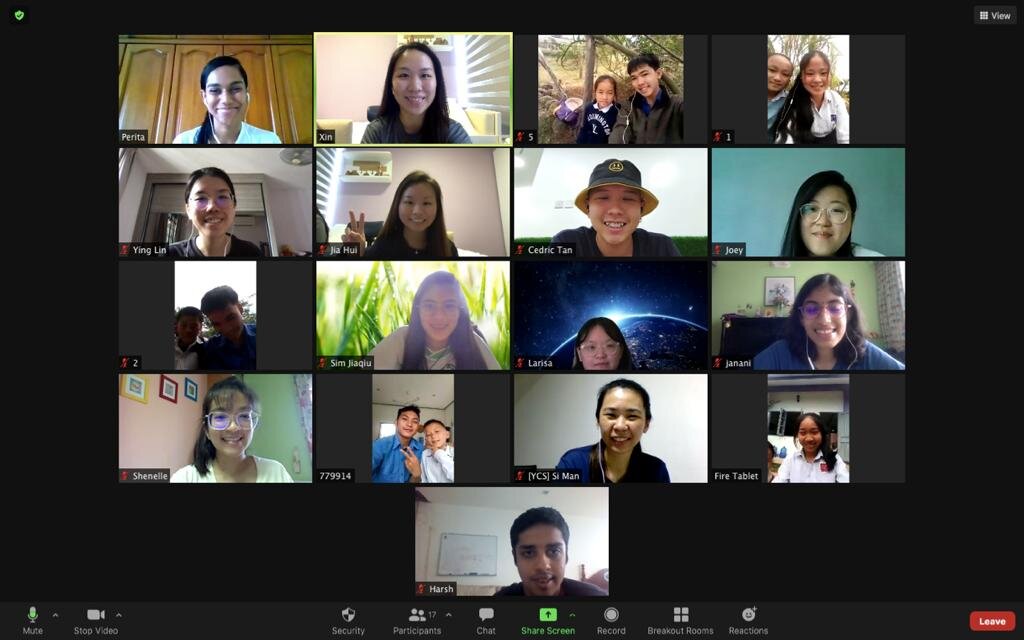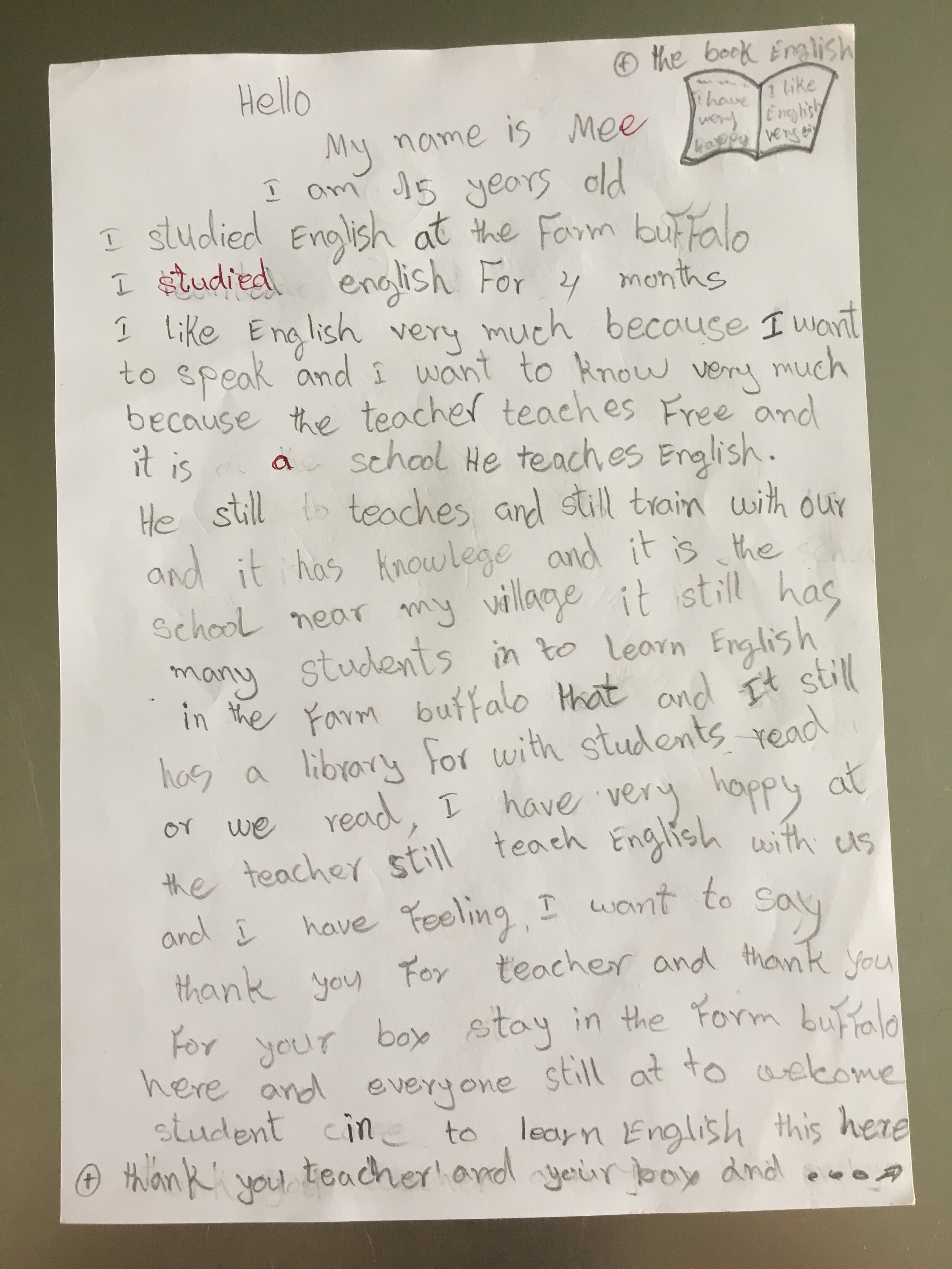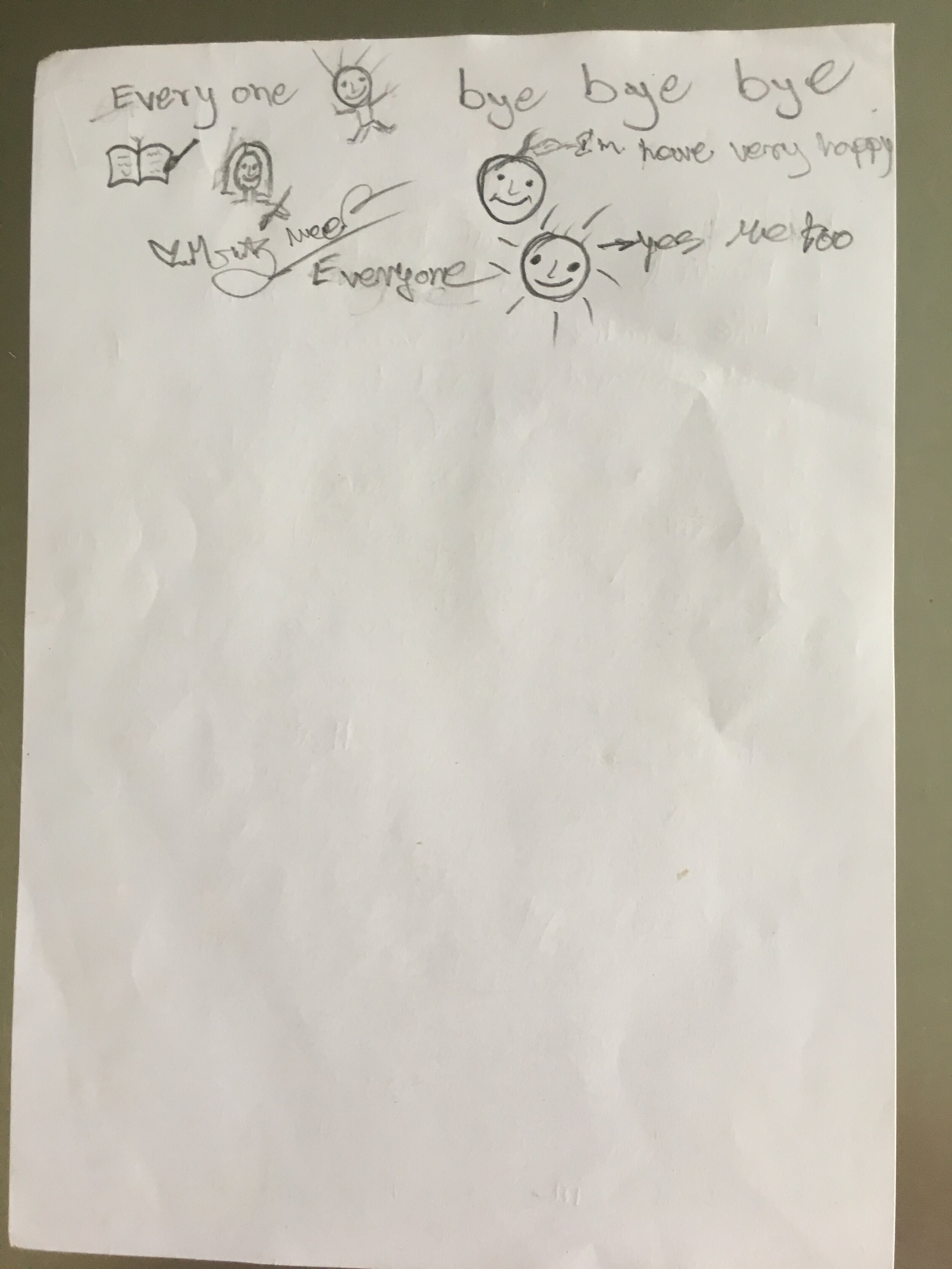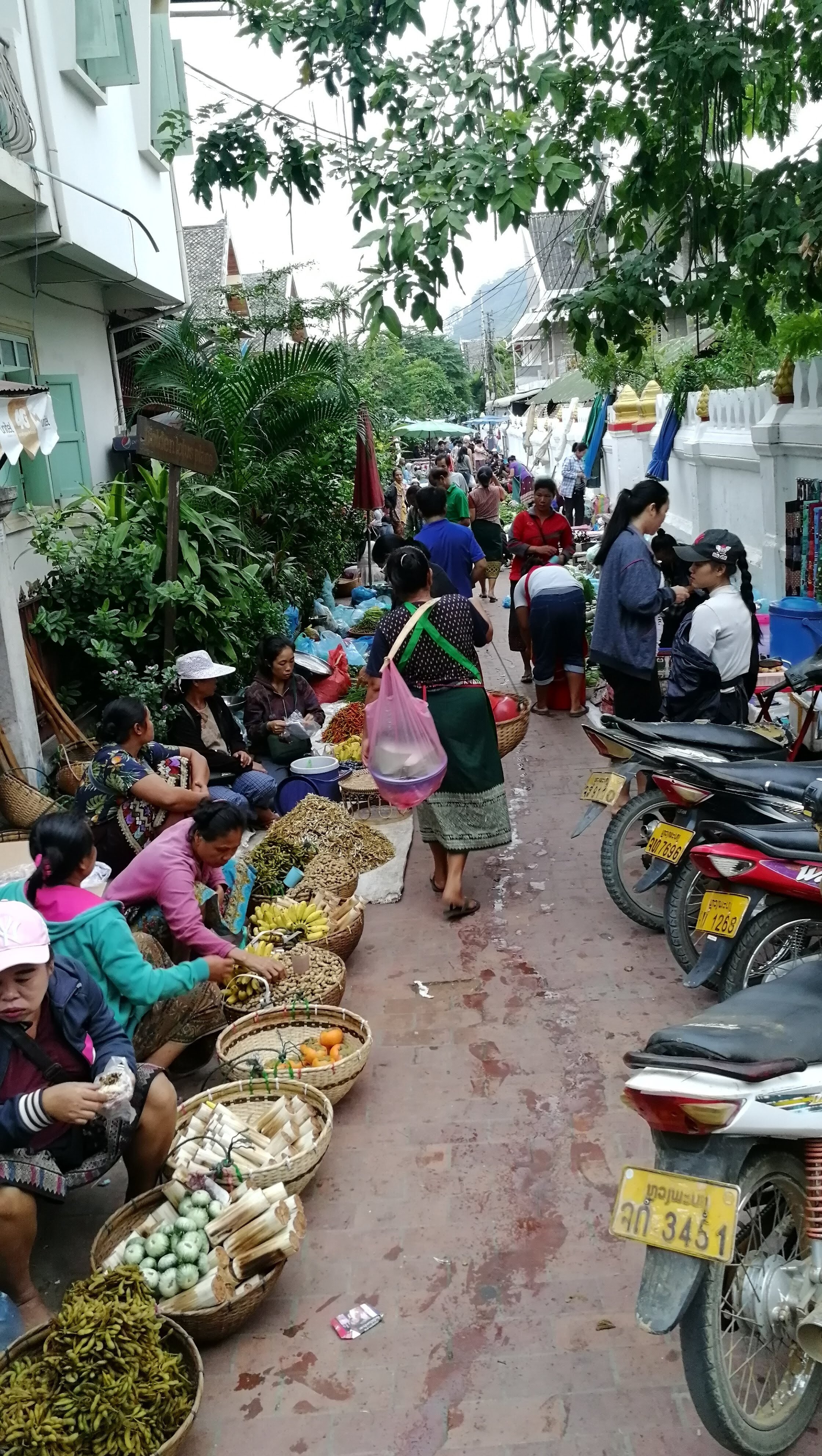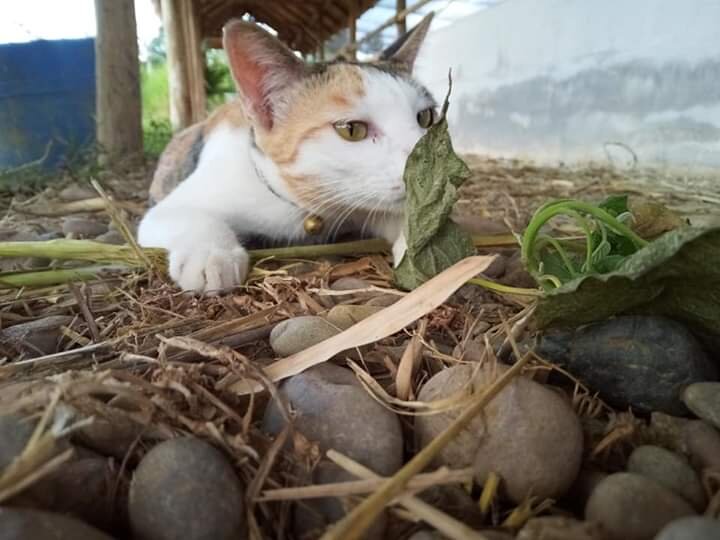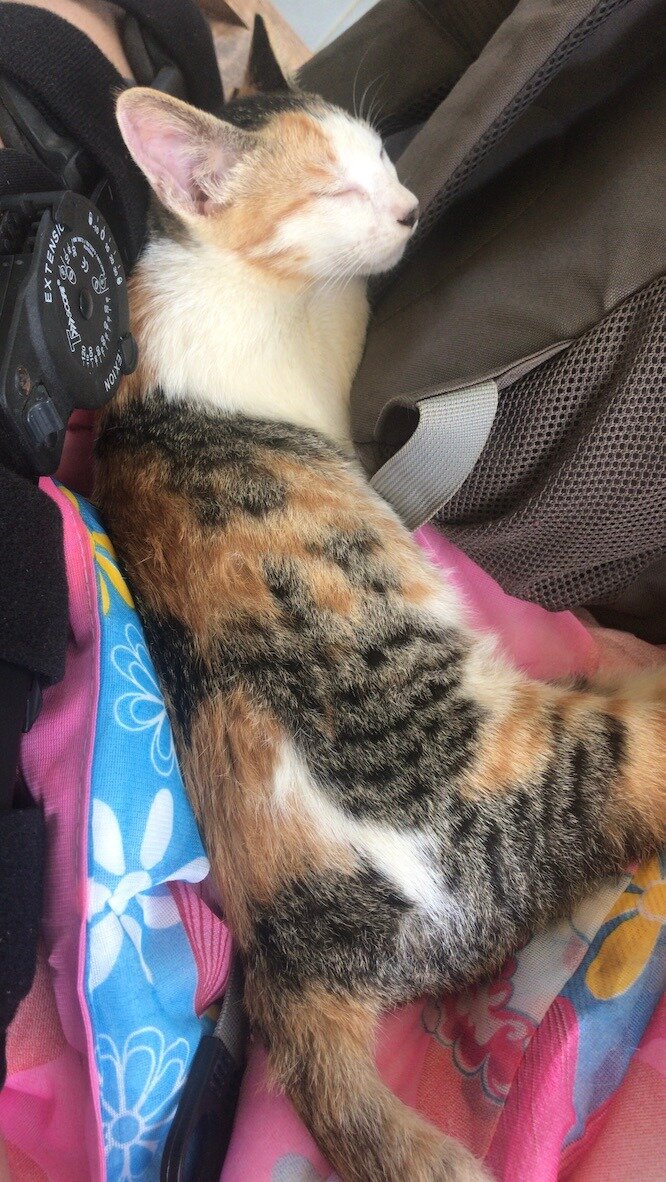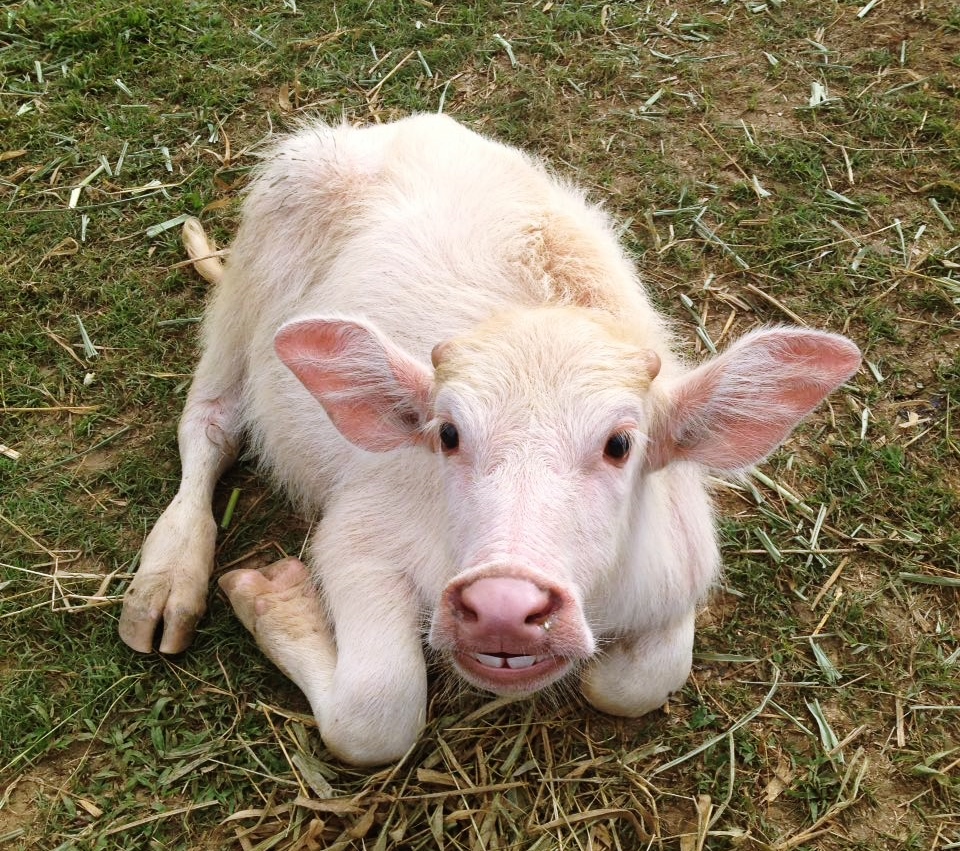
Blog
Singapore Volunteers Talk it Up!
Singapore volunteers help teach English at Laos Buffalo Dairy over Zoom during the pandemic.
For about 8 weeks in January - February, Laos Buffalo Dairy was the lucky recipient of some wonderful volunteers from Singapore that had been with us to help teach English online. That’s right! They helped teach English online to our team and to the local school children.
We had 7 team members, 5 youth teachers and 10 school children join the classes.
Caught on camera! The teachers and our local school kids during English lessons.
For about 8 weeks in January - February, Laos Buffalo Dairy was the lucky recipient of some wonderful volunteers from Singapore that had been with us to help teach English online. That’s right! They helped teach English online to our team and to the local school children.
We had 7 team members, 5 youth teachers and 10 school children join the classes.
How? Might you ask, was this possible? Well, previously we had some representatives from Youth Corps Singapore visit us at the farm. They had heard about us and wanted to talk about getting some of the Singapore youth here on a trip community service. This was all before COVID hit. We thought our chances had disappeared. But in September 2020, we received an email from Steven Lau, Assistant Director to Youth Corps Singaporeabout an opportunity. They wanted to talk to us about the possibility of going online. The Youth Corps provides short-term volunteering for youths who would like to enhance their skills and do some community service as well.
As luck would have it, back in early 2019, 10 Amazon tablets were donated to the farm for our English classes by Paul Kenton from Canada. (Paul runs a project here in Laos called Laos Village Project.) These tablets are loaded with English books and programs like Math, science programs as well. And these tablets had WIFI capability! So, through many conversations on how to make this work, we realized that we could indeed make English classes from Singapore work via online teaching.
The farm team members and the school children were broken up into small groups in order to work with each of the tablets and teachers from Singapore to get the most out of the classes. Lesson plans were drawn up from our side on what the team and children were currently learning and sent to Singapore for the volunteers to expand on. Weekly topics were also sent to help coincide with what they were learning here and allow the volunteers to come up with an in-depth plan for the week.
Classes commenced twice a week with the volunteers and twice a week with just our normal classes.
As the first few weeks passed, the Singapore volunteers decided they wanted to learn some Lao and have the farm team and children teach them. They sent us a list of easy phrases that they wished to learn and we passed that on to our students. The Volunteers reported back to us that the kids and team members were extremely enthusiastic about trying to help them learn the Lao phrases and were excited that Singapore was taking an interest!
Below is some of the feedback from both the Singaporean teachers and some of the kids.
Volunteer Joey Feedback - Joey:
I really enjoyed my time volunteering to teach the students and staff. It was very fruitful to see that at the end of every lesson we have with them, they come out of it more knowledgeable and are able to apply what they have learnt. I constantly looked forward to the sessions that we have together as they were extremely interested to learn and were not afraid to say that they do not understand, which I find very encouraging as they were keen to understand what they do not know. Moreover, even if they do not understand even after asking the volunteers, they will seek help from their friends or Link. This shows that they were really inquisitive and enjoyed the learning process.
One takeaway, that I find really meaningful, was a couple of sessions where the student teachers taught us some words and common sentences in Lao. The student teachers were really engaging and really supported our learning by constantly praising and smiling at our efforts to learn their language.
These students and staff are really resilient when it comes to learning within a limited time frame while also having to deal with internet connectivity issues. They persevere and continue to learn no matter the circumstance and I really admire them for that.
All in all, I hope to be able to be part of this project again should the opportunity arise! Meanwhile, continue to be curious and keep going forward on this path of learning. I hope we meet again!
Project Angkid volunteer feedback - Belinda:
I am glad I decided to participate in this project and to have the opportunity to meet everyone! I looked forward to every lesson, to be able to see the smiles and meet my friendly students. It made me very happy when I see that my students were able to understand what was being taught and were able to learn new things. Although there was the occasional connectivity issue, we never gave up on trying and always tried to make the lessons as fulfilling as possible. I hope my students enjoyed the lessons as much as I did teach!
Project Angkid Leader’s Feedback - Xin Yi:
Prior to YEP-GO, I have gone overseas for community projects. Due to travel restrictions, I thought it was not possible to volunteer and serve overseas. When I was introduced to YEP Goes Online, I had to take the chance and give it a try. Despite facing various challenges, the past few months, I have learnt so much through this journey. Having to juggle studying, working and coordinating Project Angkid taught me how to better manage my time. It was my pleasure to meet and work alongside such inspiring individuals. I look forward to the weekly sessions and preparing the content for our community partner, Laos Buffalo Dairy.
Our students had a good attitude towards learning which made teaching them a joy. It was my motivation seeing how much they enjoy learning new facts and acquiring new knowledge. As a team, we made sure to listen to their needs and wants. Every session we strive to improve and be better than the previous. It’s been an eye-opening and humbling experience for me. I have definitely gained more than what I gave. This also made me realize how education is often taken for granted as it comes so natural for Singaporeans. Whereas students in Laos are so eager to learn but they lack resources that come easy for us.
I am glad I was given the opportunity to lead this project with Perita. As I have gained new knowledge on managing a team virtually, facilitation skills and being able to adapt to situations. This will not be the last time I volunteer; it is only the start of learning how to be a better individual and inspiring more people to be on this journey.
Project Angkid Leader’s Feedback - Perita:
This was my first-time being a part of collaboration with an overseas community partner. Laos Buffalo Dairy was very welcoming and truly enjoyed the collaboration with them. As I have not been to any Youth Expedition Program prior and this was my first-time, I was quite uncertain and nervous how it’s going to turn out to be especially the engagement being online, Youth Expedition Project Goes-online (YEP-GO). It turned out to be enjoyable indeed and the students from Laos Buffalo Dairy had such a positive attitude towards learning. Despite the differences the volunteers and the students were both excited for the sessions, the differences made us curious about each other and to learn about each other’s culture and environment. It definitely opened my eyes with the little things that I have taken for granted for such as having a stable Wi-Fi. It was a pleasure leading with Xin Yi, with her positive attitude, it kept me going and to always do better for the next session. This was extremely enriching experience and I would love to take part again!
Here is Mee’s feedback on the class. Not bad for someone who has only been studying English with us for 4 months, huh? 😊
Hello
My name is Mee
I am 15 years old
I studied English at the Farm buffalo
I studied English for 4 months
I like English very much because I want to speak and I want to know very much because the teacher teaches Free and it is a school He teaches English.
He still teaches and still train with our and it has knowledge and it is the school near my village it still has many students in to learn English in the Farm buffalo that and It still has a library for with students read or we read, I have very happy at the teacher still teach English with us and I have feeling I want to say thank you for teacher and thank you for your boy stay in the Farm buffalo here and everyone still at to welcome student in to learn English the here + thank you teacher! And your boy and Everyone bye bye bye
HAVE YOU SEEN OUR SOCIAL MEDIA THIS WEEK?
If not, pop on over to facebook/laosbuffalodairy or instagram/laosbuffalodairy to see what we have been up to!
Share The Wonder is a non-profit that organises fun and educational day trips for underprivileged children. The organisation launched in late 2020 and has so far organised trips in Cambodia, Laos and Vietnam for children living on the streets and in slums, handicapped children and impoverished children with limited opportunities in life.
Share The Wonder partners with reputable children’s NGOs and social travel enterprises to maximize the impact of their day trips on the children they support. They believe that every child should have the opportunity to experience the eye-opening and inspiring wonders of travel, no matter where they are from or their background.
You can help us help more children by going to the website and making a donation.
Guest Blog - Peter Wiechers
“In Vietnam they plant the rice, in Cambodia they tend to the rice, but in Laos they listen to the rice grow.”
Peter “driving” a tuk tuk.
This quote is attributed to the French colonists of Indochina, and at the time probably wasn’t too complementary. Nonetheless, after independence there still remains a noticeable French influence in the country as well as increasing numbers of recent ex-pats. The once slightly condescending “but in Lao they listen to the rice grow” remains, but it’s meaning - by a modern day, a bit more enlightened developed world - probably serves as more of a reflection of Buddhism in Laos: heightened awareness, and the ability to be in the here and now.
Peter teaching a team class.
I arrived in Luang Prabang on Halloween (October 31st) of 2016. At the time, the Buffalo Dairy was just getting started. As I remember, the site for its existence had recently changed and there was yet to be any permanent buildings. I had been graciously accepted by Susie and Rachel to work as a volunteer at their guesthouse which was located on the left bank of the Nam Kham River just a few kilometers - a good walking distance - not just from the Old Quarter, but to many other not so heavily visited parts of Luang Prabang as well.
More so than I envisioned, work at the guesthouse suited me extremely well. For the most part, I was the only native English speaker there, partnered with a Lao/Khmu/Hmong staff of 4-7 others. My duties included, but were not limited to: cooking and serving breakfast, taking reservations and checking guests in and out, and assisting when needed with housekeeping. By far and away the best part of all was working with the local staff. From the beginning I was amazed with how much patience they had with me. When I would make mistakes I would be corrected with a smile and a “bor bpen yang” (it doesn’t matter). A lot of my complaints about the U.S. (and a big chunk of the rest of the world) - the sometimes gruff mannered I-don’t-have-time-to-be-pleasant-with-you, just doesn’t seem to happen much in Laos.
Just before leaving LPB, Peter went and had lunch with Twee -right - (our maiban from the guesthouse) and her family.
Susie was often around the guesthouse (her office was upstairs) but she was inundated - I should say, beyond well inundated - with what seemed to me to be the completely crazy task of setting up the first of its kind Buffalo Dairy in this third world country! At the time I had a private joke running in my head that went something like this: God had specifically put Susie on earth in case his plans for the Second Coming, or Armageddon, or whatever you want to call it were to go awry, he would then at least be assured of having some on-the-ground reliable backup. I’m glad that hasn’t come to pass...yet.
In February of 2017, Susie, Rachel, and Steven felt that they were well on their way to putting a full time effort into the dairy, so they passed proprietorship of the guesthouse back to the original owner. By this time I was living at Rachel’s house with her family and commuting by tuk-tuk to the farm. My new task there was completely different from my work at the guesthouse. I was now setting up an English class for approximately 8-12 dairy employees. This work I found to be a bit more challenging (the students were not all at the same level) than that of what I was doing at the guesthouse. I also found that the Lao students, with their ever present politeness, were less inclined than their guesthouse counterparts to give me feedback on what was and wasn’t working for them. Even though having 20 years experience teaching high school history and science in California, I found that serving in a somewhat equal role at the guesthouse suited me better than that of being an “expert” (of which I wasn’t) at the new school. Nonetheless, I feel that I did a more than adequate job in setting things up. When it came time for me to return home I was able to have a full week with my replacement volunteer, Alfredo. It was satisfying to see that he was in tune with the program I had set up, and was already incorporating some of his own ideas to make improvements.
All in all, I’m really happy with the experiences I had at the guesthouse and on the farm. It’s great to see online just how far Susie, Rachel, and Steven have progressed in these four past years. Perhaps someday I will return for a second go around!
Peter’s last day at English classes, handing over to Alfredo.
HAVE YOU SEEN OUR SOCIAL MEDIA THIS WEEK?
If not, pop on over to facebook/laosbuffalodairy or instagram/laosbuffalodairy to see what we have been up to!
The Laos Buffalo Dairy Story Part 4 - A Virtual Tour of the Mini Farm
Over the previous three blog posts, we have shared with you the story of how we got to where we are today! I think you will agree it has been quite an adventure and, indeed, continues to be so. So today, we thought it made sense to take you on a virtual tour of our mini-farm. We would much rather be able to share the tour in person however, unless you are already in Laos (in which case come and say Hi!), then this is definitely the next best thing :0)
Over the previous three blog posts, we have shared with you the story of how we got to where we are today! I think you will agree it has been quite an adventure and, indeed, continues to be so. So today, we thought it made sense to take you on a virtual tour of our mini-farm. We would much rather be able to share the tour in person however, unless you are already in Laos (in which case come and say Hi!), then this is definitely the next best thing :0)
Welcome to the Laos Buffalo Dairy! We are going to start by heading to the café to wash our hands before we visit the animals. On the way, one of the first things you might notice is that there are other animals than buffalo on the farm. That’s because when we started building the dairy we decided that there were some other projects we could include in the design. The mini-farm was built as a space for farmer training as well as a kid friendly space for families on holiday to come and discover.
When we first arrived, Luang Prabang didn’t have many activities for kids to do. And, we all know that if you go on a family holiday and your kids don’t have fun, then neither do you! So, the mini-farm is a hang out where kids, of all ages, can get up close and personal with animals.
We also knew, after some observation and research, that there were better methods of raising animals in Laos, but we, as foreigners, couldn’t just come in and say, “Hey, you’re doing it all wrong! Change everything you’re doing.” The mini-farm serves as a practical “seeing is believing” demonstration that we share with farmers. Everything we built uses local materials, so farmers can have a look and see that they can reproduce the same for themselves. While some of our structures are bigger or grander than necessary because it’s a tourist stop, farmers can see how to scale it for their own needs. Seeing it work, takes the fear out for the farmer, who will then be more inclined to try it out.
This Little Piggy
For example, our pig pen is situated near the main office and the café. No one in their right mind would do that unless they could be certain the method we applied worked! No-one wants to eat or work near a smelly pig pen! Our pen has been dug down to a significant depth, and the pen is filled in with rice bran husk or Job’s Tears. The husk is a byproduct that the farmers usually burn, which in turn is harmful to the environment. The rice bran husk stays in the pen for 3-4 months, and helps to absorb the smells. Our team removes the solid waste daily, which also helps to keep the smell down. The pigs are constantly digging in the husk, which helps turn it over and create a nice organic material - I do ask the pigs as they dig to find me truffles, but, so far, no luck - ha ha! At the end of the 3-4 months, we clear out the husk from the pen and put it on our crops as an organic fertilizer, which saves us money.
Bunny Palace
The next stop is to the rollicking rabbits. The rabbits will come rushing over to say hello and see what you might be about to feed them! Farmers in Laos do breed rabbits for food, but the rabbits are mostly very skinny and there aren’t many of them. Our bunny palace is a good way to show farmers how to breed and look after rabbits. In Laos, most farmers raise their rabbits in cages on the ground, leaving the rabbits with no ability to get off the wet ground when it rains (and Laos has a rainy season!). Rabbits are actually very delicate and cannot tolerate a lot of heat or wetness. The bunny palace is set up on stilts so the rabbits can escape the wet ground when needed. There’s also a concrete pad underneath the hutches which helps wick away some extra water and, in the summer, it provides a cool spot for them to relax in the shade.
Rabbits are a great resource for people looking for a good, fast growing source of protein. Rabbits can get pregnant for the first time at around six months of age. Rabbits have a divided uterus, so they can have two separate pregnancies going on at the same time and they are pregnant for about one month - who’d have thought! Also, did you know that a litter of rabbits is called a ‘fluffle’? Isn’t that cute! So, in a country like Laos where there are many poor and undernourished people, breeding rabbits can be a good option as a source of protein. A rabbit only costs about $12, as opposed to a buffalo that costs about $1,200, and of course rabbits reproduce much faster.
Training Room
The next stop is the training room/library. At the farm, we offer free English classes to any of our team who are interested to learn. When we first started the farm, there was no one out here who taught English, and our team wanted to go back to town for lessons. But that didn’t work for us. It took them an hour to travel each way, and then an hour for class, and class wouldn’t start before 9am at the earliest. So, that was three hours out of the work day when the animals needed tending. The solution; we started English lessons on the farm. And we currently offer them four times a week, as opposed to just once a week in town. In the beginning we had volunteers come and teach for us. Our very first English teaching volunteer, Peter, set up the initial lesson plans for us and we had a few volunteers who came after who tried to keep the lesson plans going, but eventually we saw that they all reverted back to, “Hello, my name is... What’s your name?” You can read more about our English classes by clicking here.
Because of our affiliation with the government and our work with the Northern Agricultural & Forestry College and Souphanouvong University, we managed to arrange for English at the farm to expand to the local community. Since no one out this far taught English we had a very happy community. We were lucky enough to have a conversation one day with GVI – a group in town that teaches English - mostly to monks, but to others as well – that led to a collaboration to teach at the farm. GVI would come out with their volunteers and teach a few days a week and continue the lesson plans going forward from where our team was up to. It ended up being a win-win.
Our training room has recently been transformed into an after-school library for the kids. In December 2019, we received a donation to help make this transformation happen and the high school kids from VIS in Vientiane came to help set it up. You can read more about our local Lao teachers and community English lessons by clicking here.
Milking Area
The milking area is where our visitors can have a go at milking a buffalo! After the milking, we meet some of the mums and calves and get up close and personal for our selfie pictures. Not sure who enjoys this more, the visitors or the buffalo! Our buffalo love to be cuddled and after the cuddles, they expect a bath. Our intrepid visitors can get out the hose and scrub brushes and try to make funky hair styles on the Murrah cross breeds, as they have longer hair, perfect for styling. But even if you just want to stroke the buffalo with a scrub brush, they will happily stand still and take in all the attention. We call it buffalo gushiness!
Buffalo Feeding
After bathing the buffalo, walk over to the outside of the pen and feed the buffalo some Napier grass. Each buffalo eats at least 10% of its body weight a day, which amounts to about 30kg of food a day. Napier grass is extremely nutritious for the buffalo, and is also drought resistant, handy in a country like Laos where there is a long dry season. And the best part? It’s a local grass which can be found just about anywhere in Laos by the sides of the road.
Buffalo Cuties
The next pen is the cutest, as here are the buffalo calves! The calves you see here are almost always full blood Murrah babies. Once the calves reach the four-month mark, they can be fully vaccinated, which means they can come to the mini-farm and play with the guests! These buffalo adore being out here because although they are fully weaned and no longer need milk, most of our guests choose to give them a baby bottle with buffalo milk in it – they don’t strictly need it, but they LOVEit!
The Dairy - a quick peep
Step away from the calves (if you can leave all that buffalo cuteness behind) and have a peep over the fence at the working side of the farm. We can’t let you go on this side of the farm, because to be frank, we don’t know where you have been! Seriously, since we don’t own the animals we have to be careful not to let any diseases on site that may harm the animals. From here you can see the milking area and the sheds that shelter the buffalo.
If you look between some of the buildings, you can also see the tall Napier grass growing out the back. We currently have almost 17 hectares of grass, which is enough to feed 100 buffalo for a year.
As we walk back to the café, we pass our cow and calf on the right and our newest additions, the goats! Both of these play a role in the expansion of our nutrition program. You can read more about our nutrition program here And our cows here.
And now we are back at the cafe, it is time for you to enjoy some of our delicious buffalo dairy inspired treats.
HAVE YOU SEEN OUR SOCIAL MEDIA THIS WEEK?
If not, pop on over to facebook/laosbuffalodairy or instagram/laosbuffalodairy to see what we have been up to!
The Laos Buffalo Dairy Story Part 3 - Breeding Buffalo & Cute Calves
This week’s blog post is a continuation of chef Rachel sharing our story as we tell it on the farm tour. For part 1 click here. For part 2 click here.
This week’s blog post is a continuation of chef Rachel sharing our story as we tell it on the farm tour. For part 1 click here. For part 2 click here.
How we care for Pregnant Buffalo
The first pregnant buffalo arrived at the dairy, and from that moment on, we put into action a system we still use today to look after them. It begins in the fields where we check the buffalo to see if they are pregnant. When we find some that are around eight months pregnant, we arrange for them to come to the farm. If they are within 5km, they walk here, if they are further away than that, but not more than two hours away, we go and pick them up. When they arrive at the farm, we put them in quarantine for one month. During this month, we test them for diseases – Tuberculosis (TB), Brucellosis, Hemorrhagic Septicemia (HS) Water & HSOil – and then we vaccinate for Foot & Mouth and the HS diseases. Unfortunately, there are no vaccines available here in Laos for TB or Brucellosis. If we find a buffalo with brucellosis, we will not take her as it is highly contagious (for buffalo and humans) and causes miscarriages. TB, while it doesn’t affect the buffalo, does pass to humans. Luckily, we have not found any with either of these diseases in buffalo brought here!
Each day, we bring the buffalo into a crush where they are fed, bathed and get their teats played with. Remember, these are essentially wild animals, never managed in the way we handle them, so they need to learn a healthy respect for us as well as each other, so no one gets hurt. It takes about three days for the buffalo to get used to this process, after which we can open the gates, and they will willingly walk in with no issues. The reason for this? They are fed a wholesome diet brought directly to them, and buffalo love food. So, what better way to get it, then to have it brought to you!
After the first month in quarantine, we move the buffalo to the sheds where they spend the next month getting fat and healthy because a healthy mum generally means a healthy calf. She will spend the next month here, relaxing and eating well. When a female buffalo starts to show signs of labour – we’ve had some labours last up to three weeks – we move her into our maternity section so we can keep an eye on her. For the most part, we don’t need to step in and help, but occasionally, we are needed. In the last few years, we have had less than a handful of times where we have required our team members to help a calf be born. Had they not been on our farm, those calves would undoubtedly have died, and the chances are good that the mum would have as well.
Once her calf is born, mum and the calf are kept together for the first three weeks so that the calf receives the best possible start to life. This practice is very unusual, in most of the dairy sector, a mum and her calf are almost always separated at birth and not reunited. But for us, that isn’t an option. As we don’t own these animals, we need to make sure that the female buffalo and her calf develop a close bond, so that when they go back to the farmer, the calf doesn’t get lost in the fields. For a farmer to have a calf wander off, would be like having the interest on your bank account wandering off!
A mum and baby relaxing together in the sheds.
After the first three weeks, we only separate the mum and calf at night. Mum comes in first thing in the morning and is milked and then we put her back with her calf for the rest of the day so the calf can continue to bond and also have mum’s milk. We found that this method is healthier for both the female buffalo and her calf. The calves quickly get used to this routine. If you happen to be on the dairy site in the evening, you can see the calves walking away from mum and going to put themselves to bed in the night time pen. They get so used to the routine that we can even leave the gates open, and they won’t go anywhere until morning. That is of course, except for the very cheeky calves, who are likely to sneak off at night for a warm drink. ☺
Morning milking sessions.
When we start milking the female buffalo, then we start paying the farmer a rental fee. But how much the farmer receives depends on his buffalo. The buffalo provide milk for approximately six months. If the buffalo is a good milker, then we can milk her longer and pay more, but if she is not a good milker, we can milk less and pay less.
Feeding the buffalo on the mini farm before she goes home to her farmer.
After six months of milking, we move the mother from the dairy side of the farm to the tourist mini-farm. Here, the buffalo is the star attraction in the milking demonstration, while we dry her off. Your average dairy cow gives you between 30 and 70 liters of milk a day, but buffalo provide much less. Our local Swamp buffalo only provide about 2.5 liters a day, so when they get to the mini-farm for drying off, they only give a few hundred grams of milk a day. This is why buffalo products cost so much more than cow’s milk product. After their time on the mini-farm, we return them to the farmer. We aim to return all the buffalo when they are between 3-4 months pregnant, and with better genetics on board.
Ferdinand, our friendly Murrah buffalo, posing for the camera.
How we stumbled into setting up a Breeding Program
In 2016 when we were first setting up the farm, we were looking to own the buffalo. However, while calling and emailing around to look for buffalo to buy, we stumbled across the GuangSi Institute in China. When we asked them if we could purchase buffalo from them, they promptly told us no because they only sell to public and government entities, and we were neither. We thanked them and went on our merry way. But then, they emailed us back and asked where we were. When we told them, in Laos, they immediately thought we were affiliated with the breeding program that they had helped set up with the Laos government. They started to include us in all their correspondence back and forth with the Laos government, and we were able to see what was going on with the program.
In June of 2016, we were invited to a meeting in Vientiane, between the Chinese and Laos governments, to ask what it was we were doing. To make a long story short, we told them that we were in the process of building a farm to house 200 buffalo at a time, 400 over a year. We knew that over the last 30 years the buffalo numbers and size in Laos had been decreasing and the genetics were changing, due to a lot of inbreeding practices, lack of vaccinations and not having the proper feed. We explained that we wanted to rent the buffalo from the farmers to milk them, and in the process crossbreed them with the Murrah buffalo that the Chinese government had brought in, to make bigger, stronger, healthier buffalo, and make them better milkers as well. Murrah buffalo can give between 8-10 liters of milk a day, so that was perfect for us.
After our explanation, it was decided that the two Murrah buffalo at the agricultural center in Vientiane should be moved to our farm, along with the whole breeding program! And so, our breeding program began.
First Murrahs on the farm - April 2017
One day, two bulls, some semen and equipment for doing the insemination process arrived at the farm and then, all we needed was training! Enter our two international vets! Dr. Ohm, is a world-renowned specialist in buffalo reproductive health and Ronald van Giessen, is a specialist in artificial semination and a specialist in Developing Nations Agricultural Projects. They each played an essential role in training our team to be able to do artificial insemination and get the breeding program up and running.
With everything in place, In December of 2016, we went to Thinkeo Village, next door to the farm, and instigated an artificial insemination program there for the buffalo. We didn’t think anything would come of it because we didn’t think the semen was viable. Still, for training purposes, it was fine. But then, shocker of all shockers, in October 2017, we got a call from Somlit, our favorite village chief at Thinkeo Village, and he told us that his buffalo had just had a baby and it was a crossbred calf. We told him we didn’t think that could be possible, but he insisted that she was, and he wanted us to bring her to the farm so we could show the other farmers that what we were doing was good for everyone. Of course, we agreed, and he brought her to the farm.
The other farmers didn’t think that you could breed a Murrah and a Swamp; they just didn’t think it was possible. Even when we had explained that we weren’t doing anything new, we were just bringing the technology and process here to Laos, and farmers had already done this in other countries, they didn’t want to believe it. So, for us, Somlit’s buffalo would be a light in the window, if she was indeed a crossbreed.
We love Somlit so much – he has always been wonderful to us. Whenever we have a crazy idea that we want to try out, we turn to Somlit and say, “What do you think about….?” He always hums and haws for a minute or two, and then says, “We’ll make it happen.” He’s a very outside the box kind of guy who is always willing to try something new.
Sophia in December 2017 after being on the farm for a month.
Oh, the lovely Sophia!
At the beginning of November, Sophia and her mum walked down the road to the farm; we confirmed that she was a crossbred calf and much rejoicing followed! Sophia and her mum stayed in quarantine for our requisite one month stay. We vaccinated mum, and before long, she and Sophia were moved to the mini-farm to greet farmers and guests. Having Sophia there allowed us to show farmers the difference between Sophia’s size and that of a local Swamp buffalo of the same age. Sophia was obviously both taller and broader. She also loved attention, and a star was born ;0).
Longer-term, it would be the responsibility of the two bulls – Ferdinand and Fabio – to maintain the breeding program. In our first year, Sophia was the only crossbred calf, but with the use of artificial insemination, we were expecting about seven more in Year 2.
Installing Laos’ first Milking Machines
So, up until about two and a half years ago, we were the only dairy in Laos. And, as you can imagine, being the first, we had to import all of our equipment from outside the country. We are still the only buffalo dairy here in Laos, but there is now at least one cow dairy in Vientiane, and we’ve heard talk about the building of another cow dairy in southern Laos.
We brought in a proper machine set up to milk 16 buffalo at a time. That is enough to milk 200 buffalo a day and 400 buffalo a year. When we get to the point that we are milking 400 buffalo over a year, the rental fees that we pay back to the farmers will amount to approximately $40,000 USD a year. All of that money goes directly into a farmer’s pockets, and it is money that they would have otherwise not gotten for their “buffalo bank account”.
Buffalo entering the waiting area for milking.
Buffalo Farm or Buffalo Spa!
In front of the milking area, is the waiting area for the buffalo. With about 60 buffalo on the farm at the moment, the buffalo come in in smaller groups and wait in the waiting area. We milk four or five buffalo at a time. While we milk them, we also feed them. After milking and feeding, they move into the “exit” room and receive a shower. Buffalo come in first thing in the morning and have a shower, in the evening they come in again for another shower and then in the middle of the day they come in for a shower and a scrub down. Once a month they get their nails done. Yep, this farm sounds more like a buffalo spa!
After the showers, the buffalo wander back to the sheds. We currently have three sheds, which provides capacity for 150 milking buffalo at a time. In the back corner is the quarantine shed. We recently expanded our quarantine, so we can now bring in about 40 buffalo at a time. We were hoping that we were going to be able to get funding this year to build the fourth and final shed so we could house 200 milking buffalo, but with everything that has happened in 2020, that isn’t to be (yet!).
Next time join us for the final part, as we take you on a virtual tour of the mini-farm. Find out who you meet and what you can get up to on a visit to the dairy.
Coming in January….. We did a Pod Cast with Foolish Careers. Keep your eyes on our media for when it goes live. Or sign up on their website at https://foolishcareers.asia for pod casts to land in your mailbox directly!
Haven’t heard of the Foolish Careers podcast before? That’s because it’s brand new! Check out the description from the website to see what constitutes a “foolish career” and why it’s a new thing! https://www.foolishcareers.asia/p/this-is-for-those-of-us-who-ignored
Will you be in Luang Prabang from 23 December - 3 January? Are you looking for something to do?
With more than 60 businesses participating, the LPB community is coming together to create a memorable December Holiday season. Come join us for all sorts of events and fun things. To find out more go http://www.whatsuplao.com/ to see all the happenings and plannings.
HAVE YOU SEEN OUR SOCIAL MEDIA THIS WEEK?
If not, pop on over to facebook/laosbuffalodairy or instagram/laosbuffalodairy to see what we have been up to!
The Laos Buffalo Dairy Story: Part 2 - Building Laos’ first dairy - the first Buffalo arrive
Part 2 Building Laos’ first dairy - the first Buffalo arrive
Three days before our six-week trial was due to end, we managed to bring in a single cow milking machine from China. This machine ran on either electricity or petrol, which is important to note, as Mr. Eh didn’t have electricity near the field at the time. The machine arrived flat packed in the early evening, and Steven and Mr. Thon, our trusty tuk tuk driver, boldly took on the chore of trying to set it up in the failing light. With the instructions translated from Chinese, loosely into English, this was no easy task. Luckily, the instructions also kind of looked like IKEA instructions with lots of pictures to guide them.
This week’s blog post is a continuation of chef Rachel sharing our story as we tell it on the farm tour. For part 1 click here.
Part 2 Building Laos’ first dairy - the first Buffalo arrive
Three days before our six-week trial was due to end, we managed to bring in a single cow milking machine from China. This machine ran on either electricity or petrol, which is important to note, as Mr. Eh didn’t have electricity near the field at the time. The machine arrived flat packed in the early evening, and Steven and Mr. Thon, our trusty tuk tuk driver, boldly took on the chore of trying to set it up in the failing light. With the instructions translated from Chinese, loosely into English, this was no easy task. Luckily, the instructions also kind of looked like IKEA instructions with lots of pictures to guide them.
The following day we were very excited to try the machine to see if we could get more milk than from milking by hand. It felt like the entire village came out to watch! They had been watching over the previous six weeks all the new and unfamiliar things that we, as the crazy falang (the term for all ‘foreigners’) had come up with. As luck would have it, not a drop of milk came out. It turned out that buffalo are very sensitive to change. The machine was noisy and it made them nervous. So, we vowed to try again the next day. Finally, with two days left, we got some milk from the machine milking approach.
Our trial finished just in time for Steven and Susie to go back to Oz for a holiday. And when they came back, it was time to sit down and discuss our next steps. We decided to move ahead with the dairy, and that meant we put the idea of building a hotel on hold!
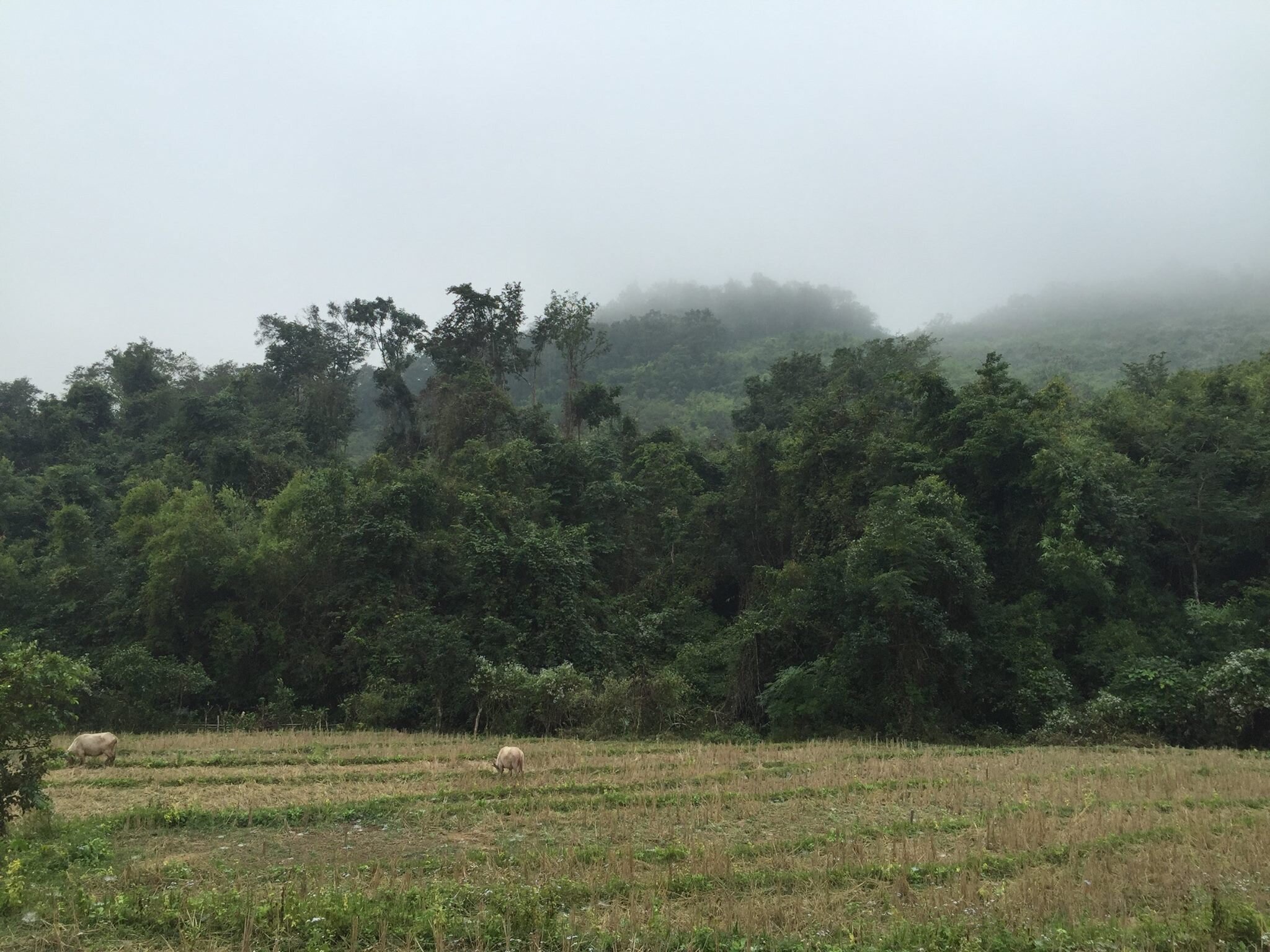
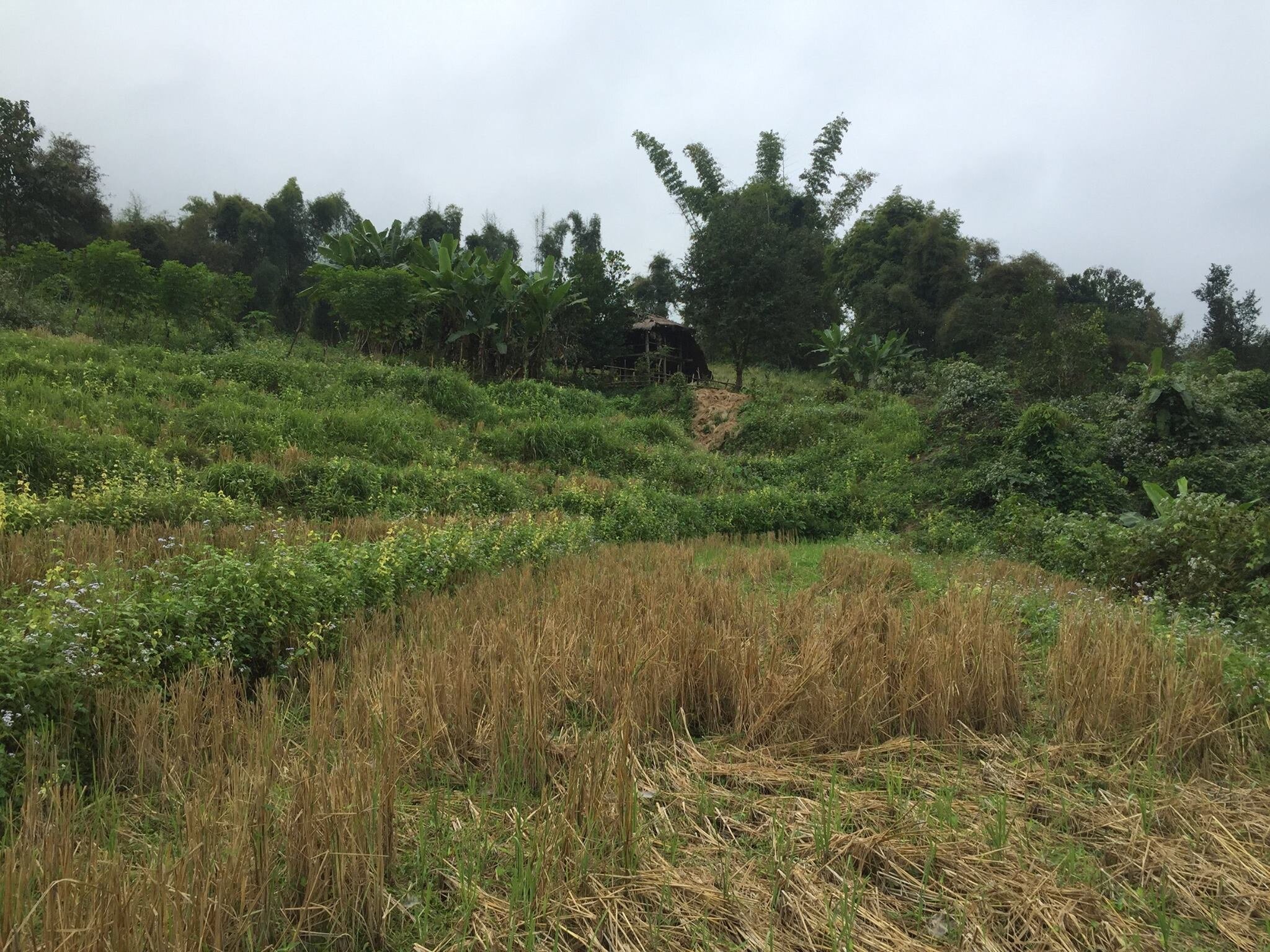
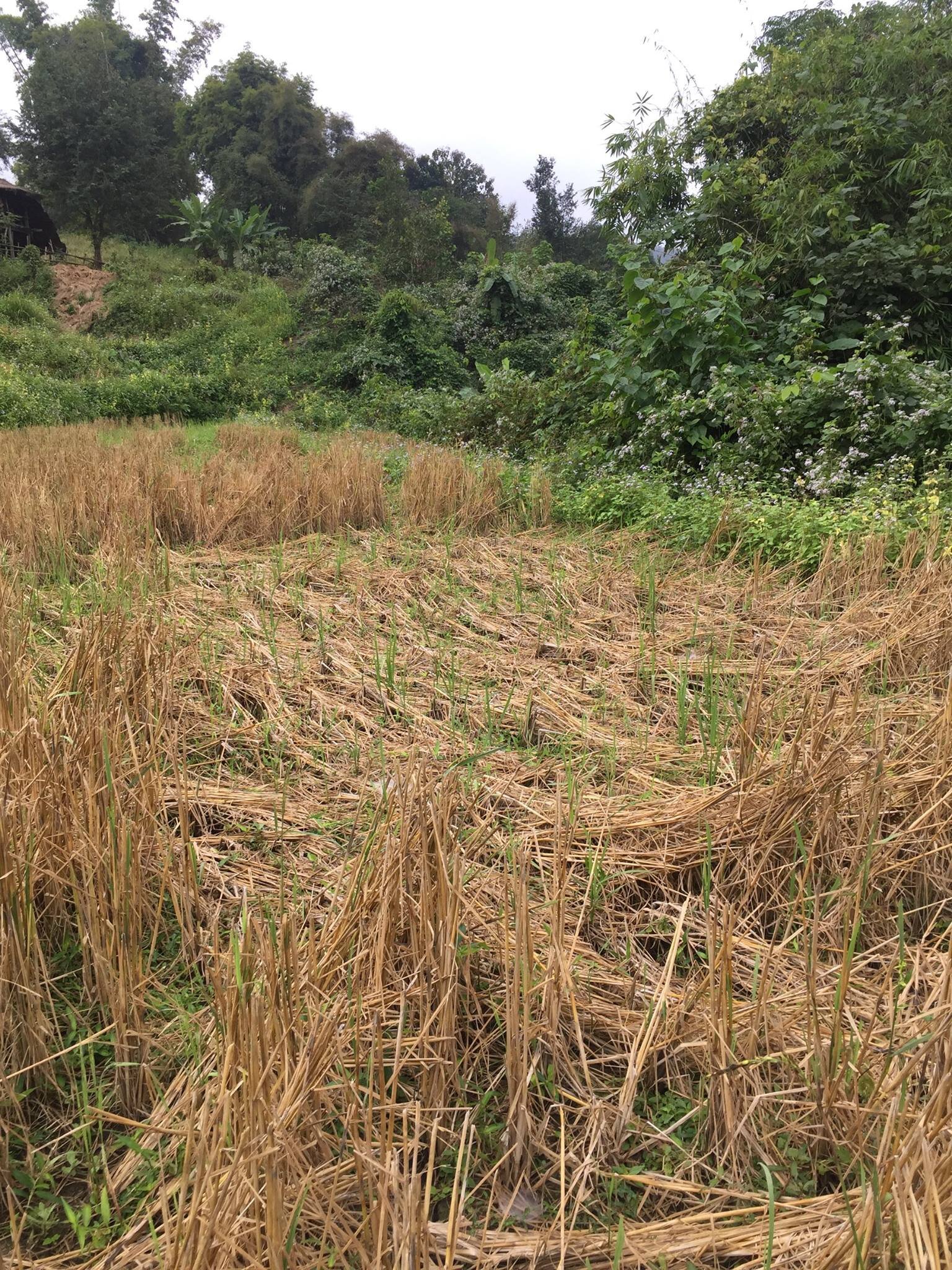
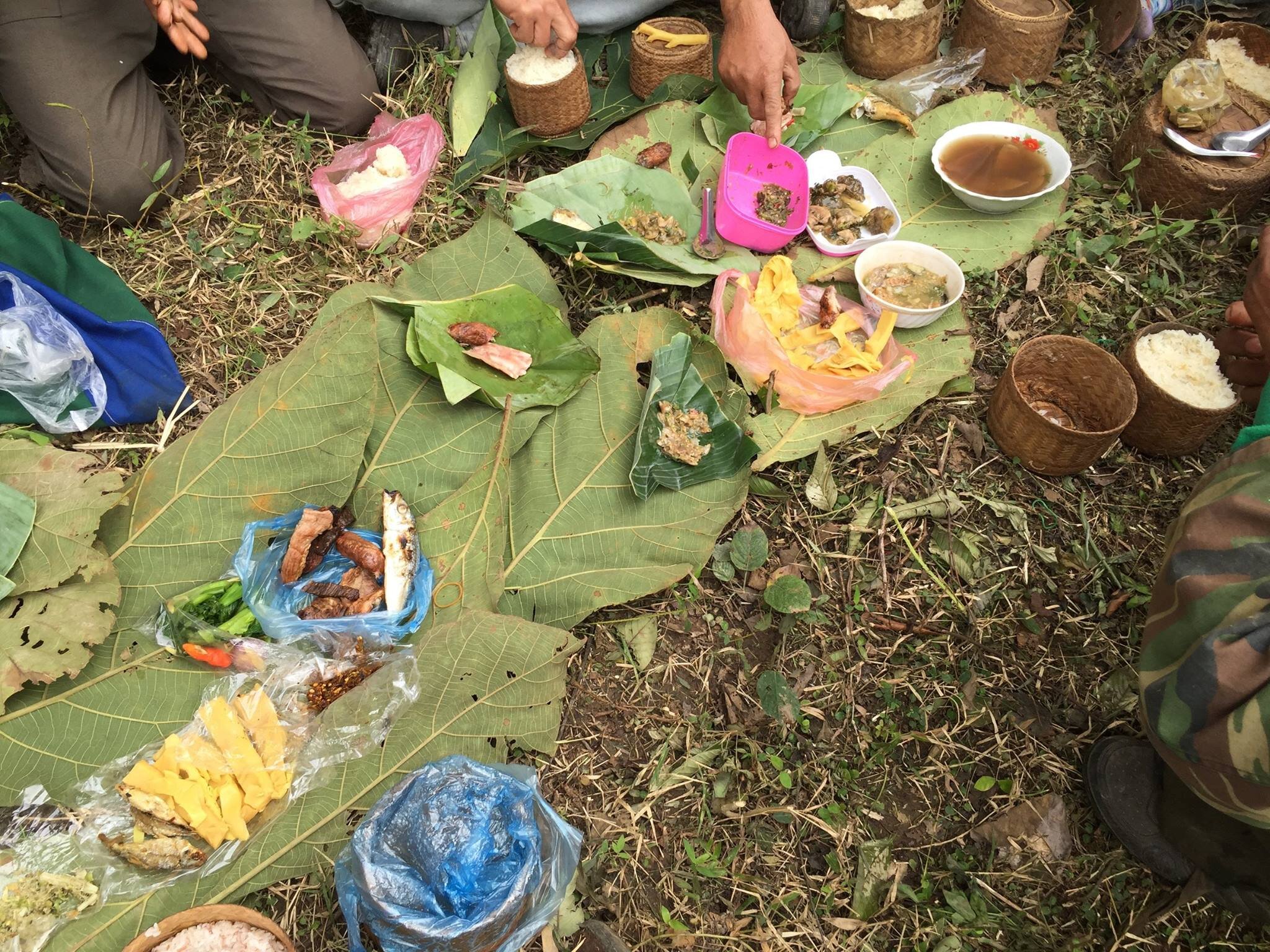
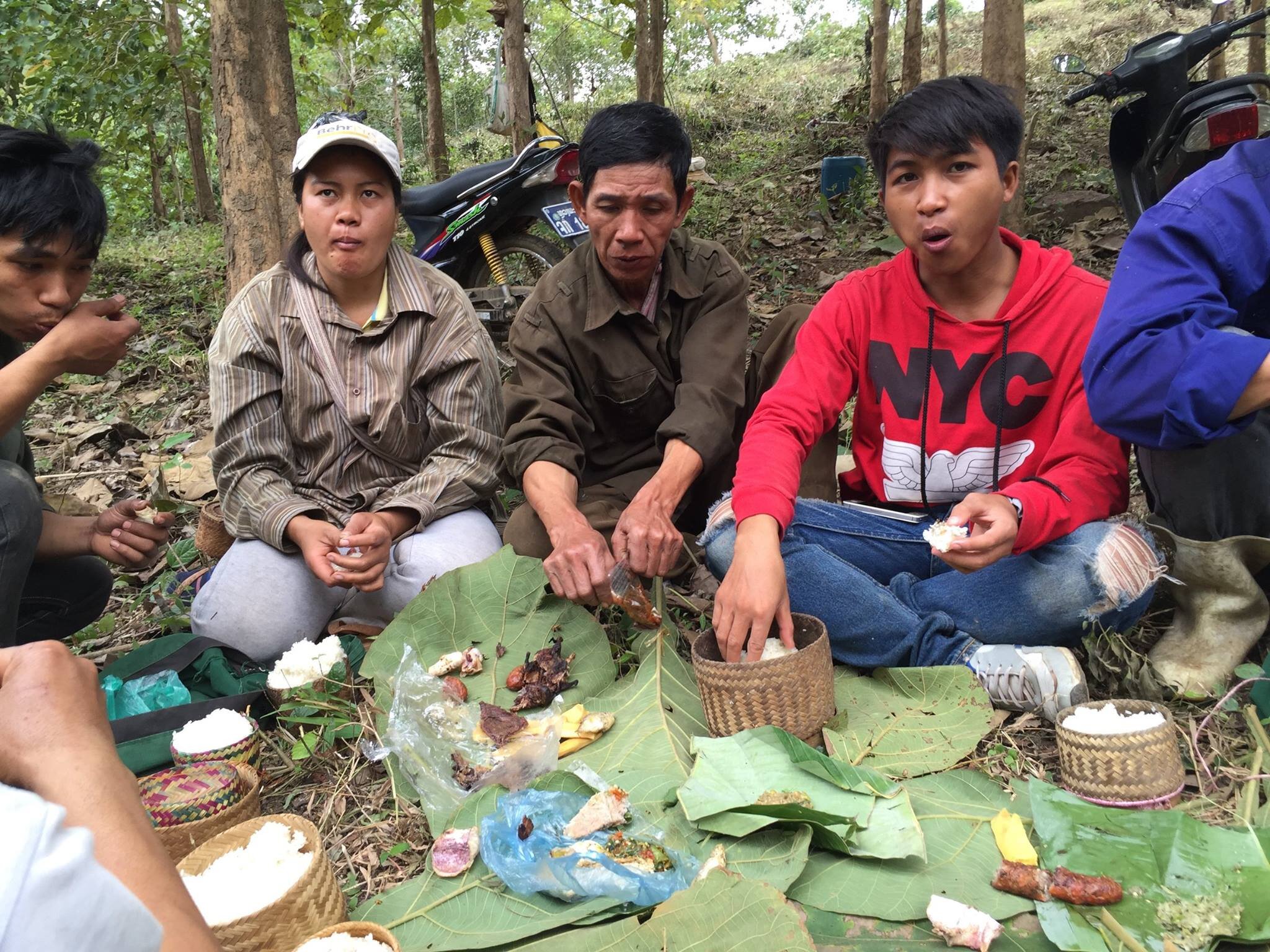
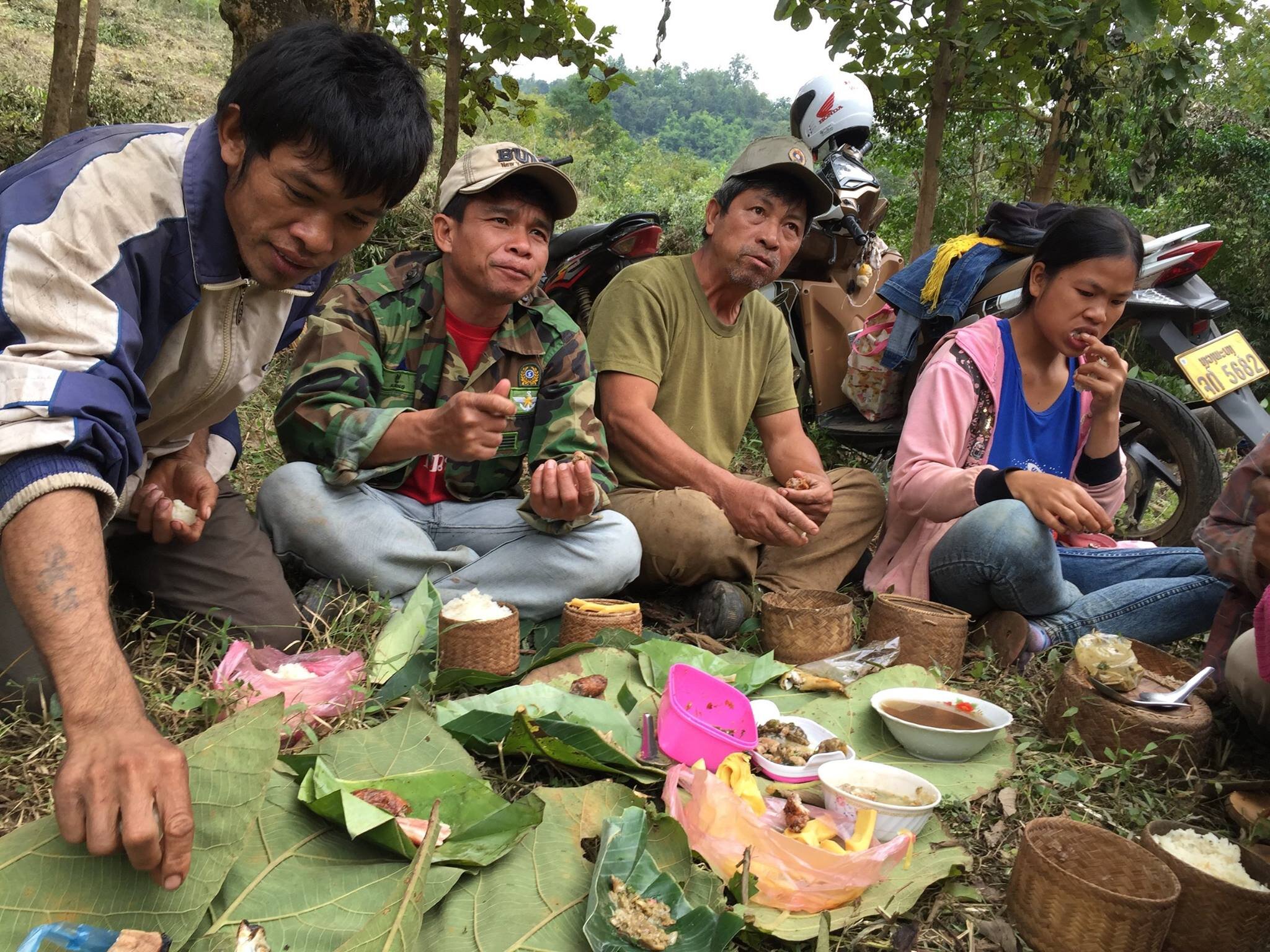
Laying the foundations of the Dairy Farm
To build a dairy we needed land, and so we sent the team out to look for somewhere suitable. They looked and talked with farmers and landholders. We looked at many parcels of land and, finally, after talking with a bunch of farmers in Ban Naxao, we decided that we had found a suitable bunch of connected properties that would work. We rented the land for a two-year period with options to renew, and spent lots of time clearing the land and building fences. We planted grass, as we knew that this was the most critical first step.
However, when we got to the point that we needed to put in a new road to continue building, we ran into a roadblock. Literally. While we had a signed piece of paper from the village chief stating that we could have four-meter-wide road access, it turned out that it was the deputy village chief who signed that and he didn’t have authority to give it to us. That and we would be going through another piece of property that wouldn’t grant us access where the road was easiest for us to build. We tried negotiating, but were constantly told, “No, you only have motorbike access.” “You can buy this one hectare of land for USD $150,000.” “You can move your road over there next to the creek coming down.” None of these were viable options for us, so we decided to stop with the plan for that site and to look elsewhere.
The team went out again to look for new land and came across the parcel of land that we still have now, in Ban Muang Khay. It was flat, check. It was empty, check. It already had electricity, check. It was on the main road with road access, check. It was on the direct route to Kuang Si Waterfall (a major tourist destination) check, check, check! And so, we began negotiations yet again for land rentals and building rights.
It took about six weeks with 40-60 people every day to clear the land of all the trash and black plastic sunk into the ground from the watermelon farm that was on the land years before. Clearance was an arduous task, but a necessary one since there would be living animals that traditionally forage on site, and we needed to make sure it was all gone to keep them healthy and safe.
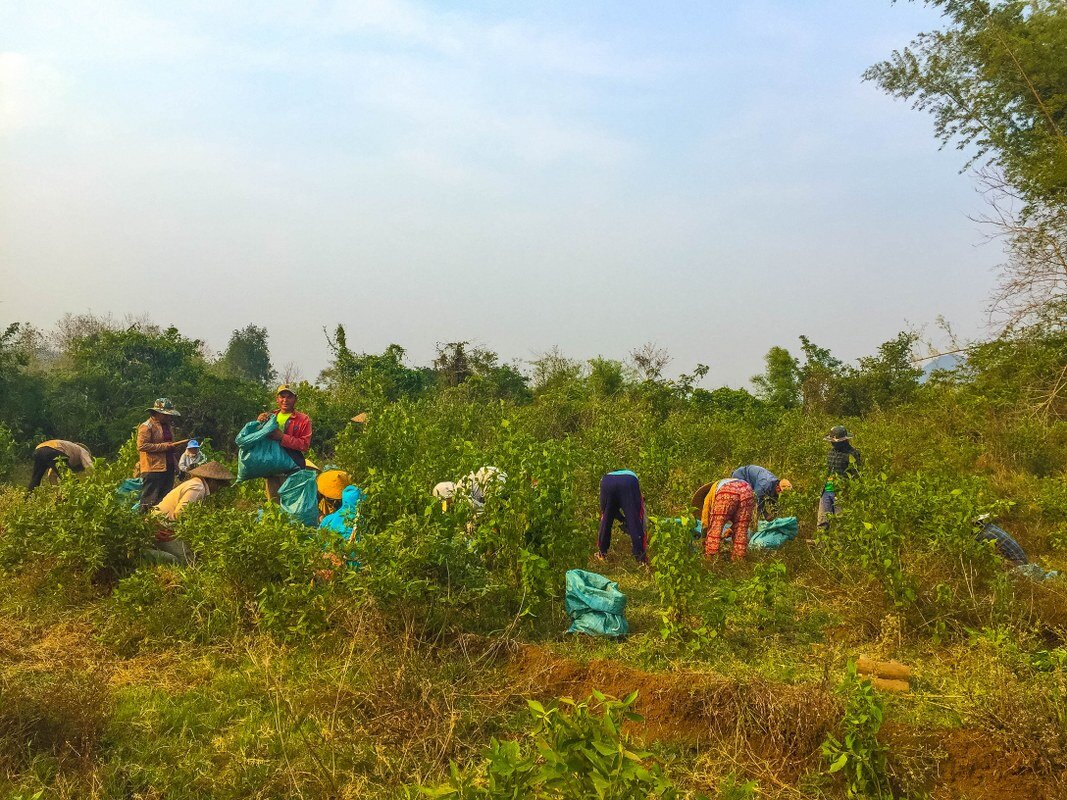
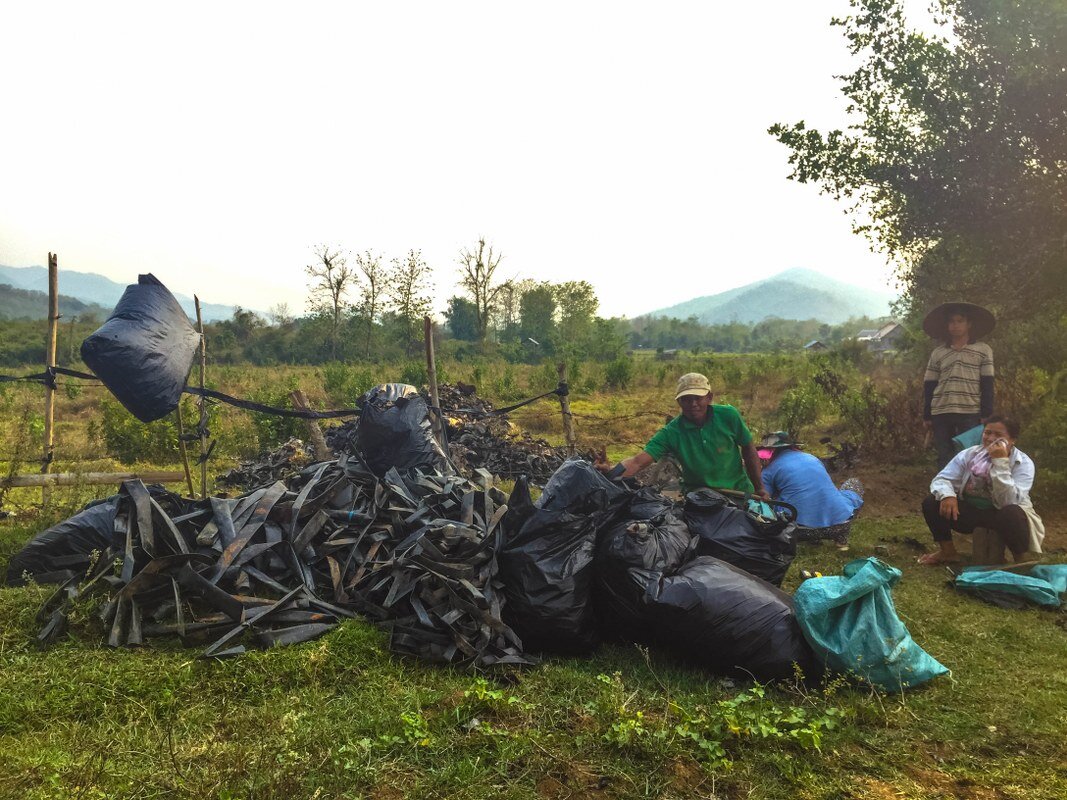
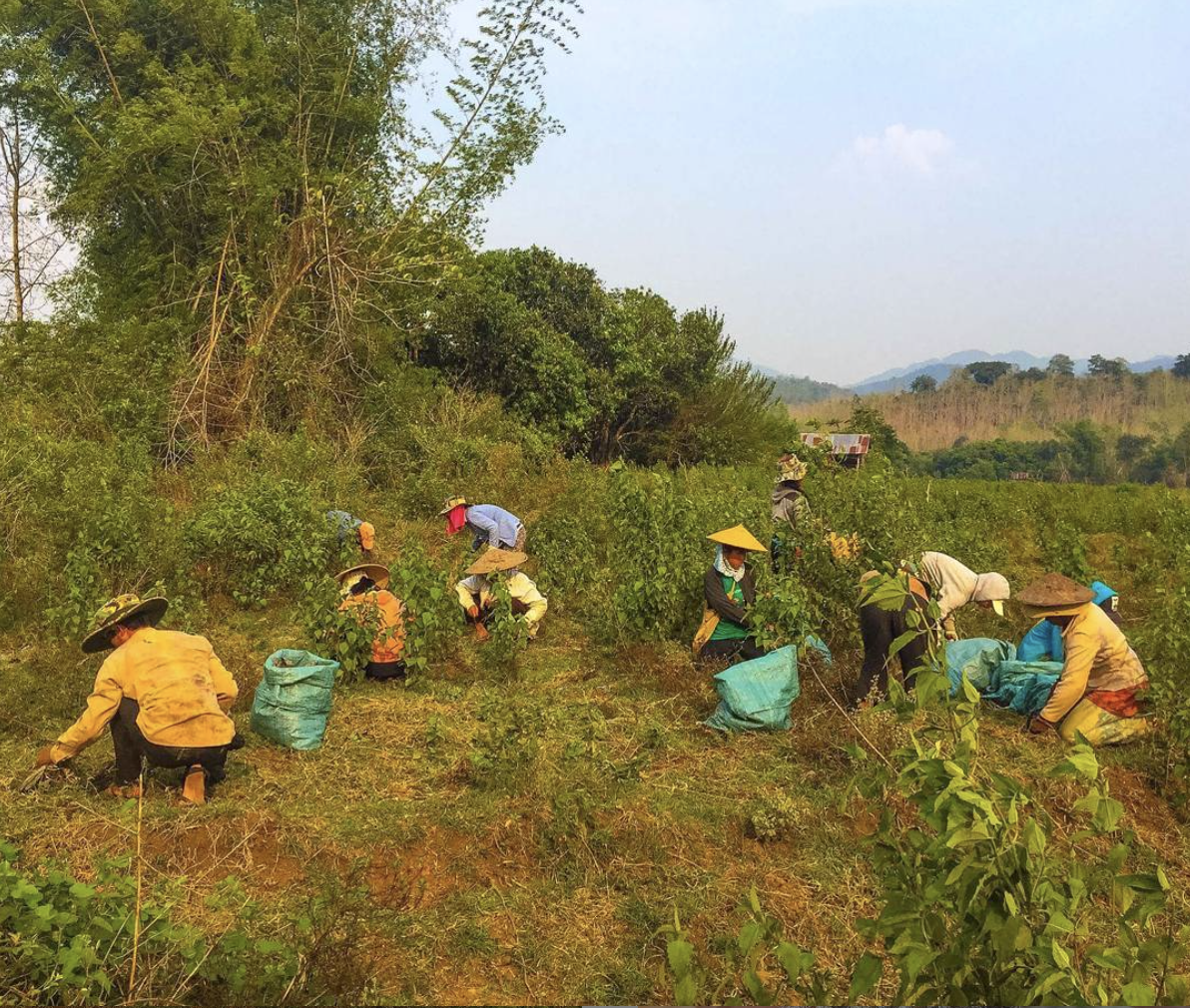
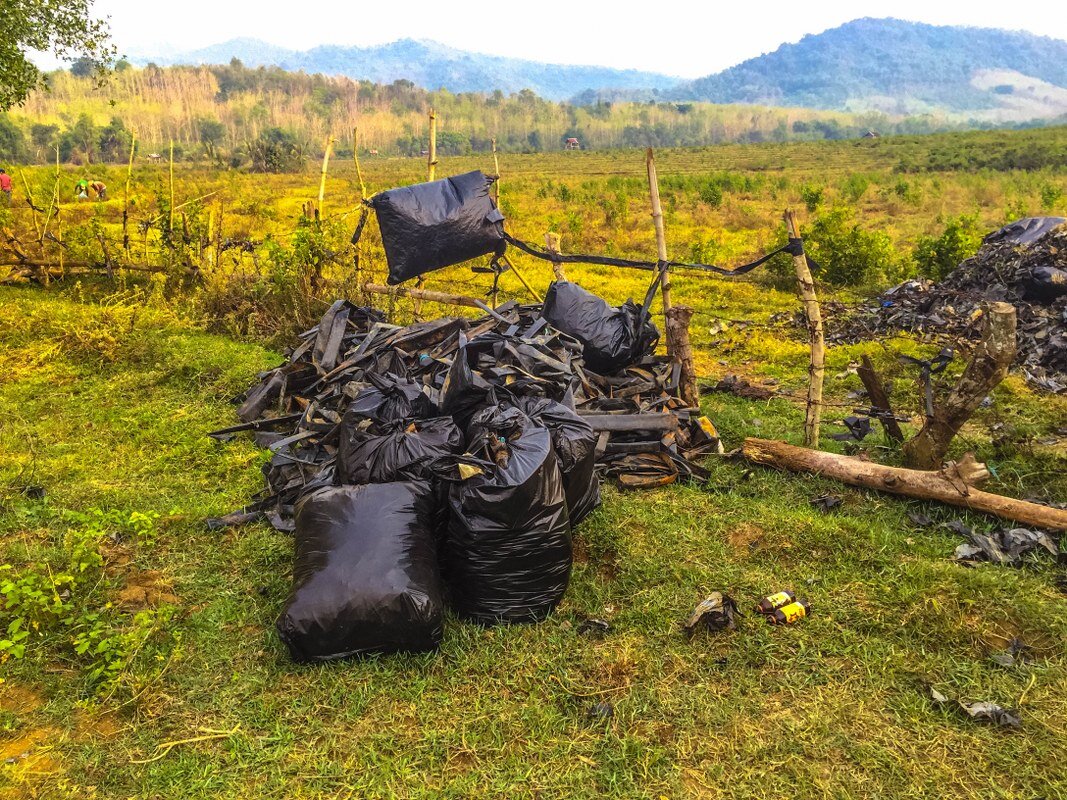
Getting the Farmers onboard
During this time, we prepared and thought about how we could convince the farmers to trust us. We knew that they wouldn’t just give us their “bank accounts”, which is essentially what a buffalo amounts to for a farmer. Farmers keep between three and five buffalo in their “herd”. When they need money to, for example, send a child to school, for a marriage, for a hospital stay, a baci ceremony (a buddhist blessing ceremony), or when someone dies, they sell as many buffalo as they need to pay for whatever it is. But, unfortunately, while the buffalo is their bank account, they don’t make any interest off it. And since they generally cannot afford to pay for vaccinations, there is no guarantee that their “bank account” will provide them with any money since the animal may end up dying of a disease. It’s like a lottery that way.
We decided to hold four informational sessions in one day, spread out over several villages – Kok Mon, Pit Nyai, Ban Jok and Ban Naxao, to talk to the farmers about our idea. Luckily, due to Susie’s persistence with the government, we had Doctor Som, and some other key agricultural officials, on our side to help with these meetings. Dr. Som is a Laos veterinarian who was trained in Cuba many years ago and had an understanding of dairies from his time abroad.
We had our team once again going to villages where there are lots of buffalo, and that are close enough to where the farm would be, to put up fliers about what we wanted to do. While they were in these villages, our team did some preliminary talking with people; asking how many buffalo they had, and would they be interested in coming for an informational session, giving them a brief intro to what we are planning.
We went to these informational meetings with our government allies and had some pretty good turnouts. It appeared more people were interested than not. And they had questions; questions about diseases and the health of buffalo; questions about diets. We answered all of the questions they had. We asked them all to sign an attendance sheet with their phone numbers and planned to have them all visit the farm soon.
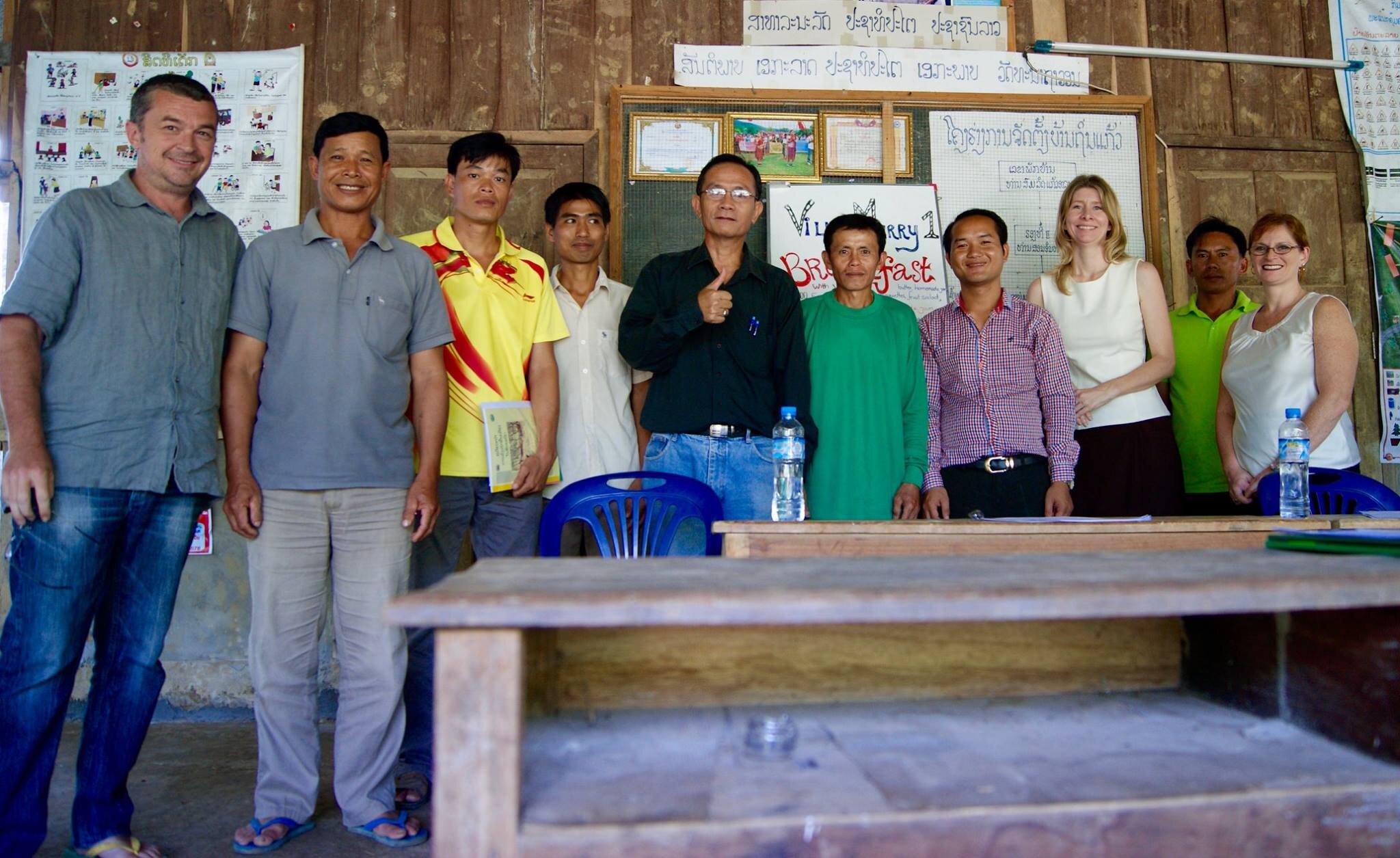
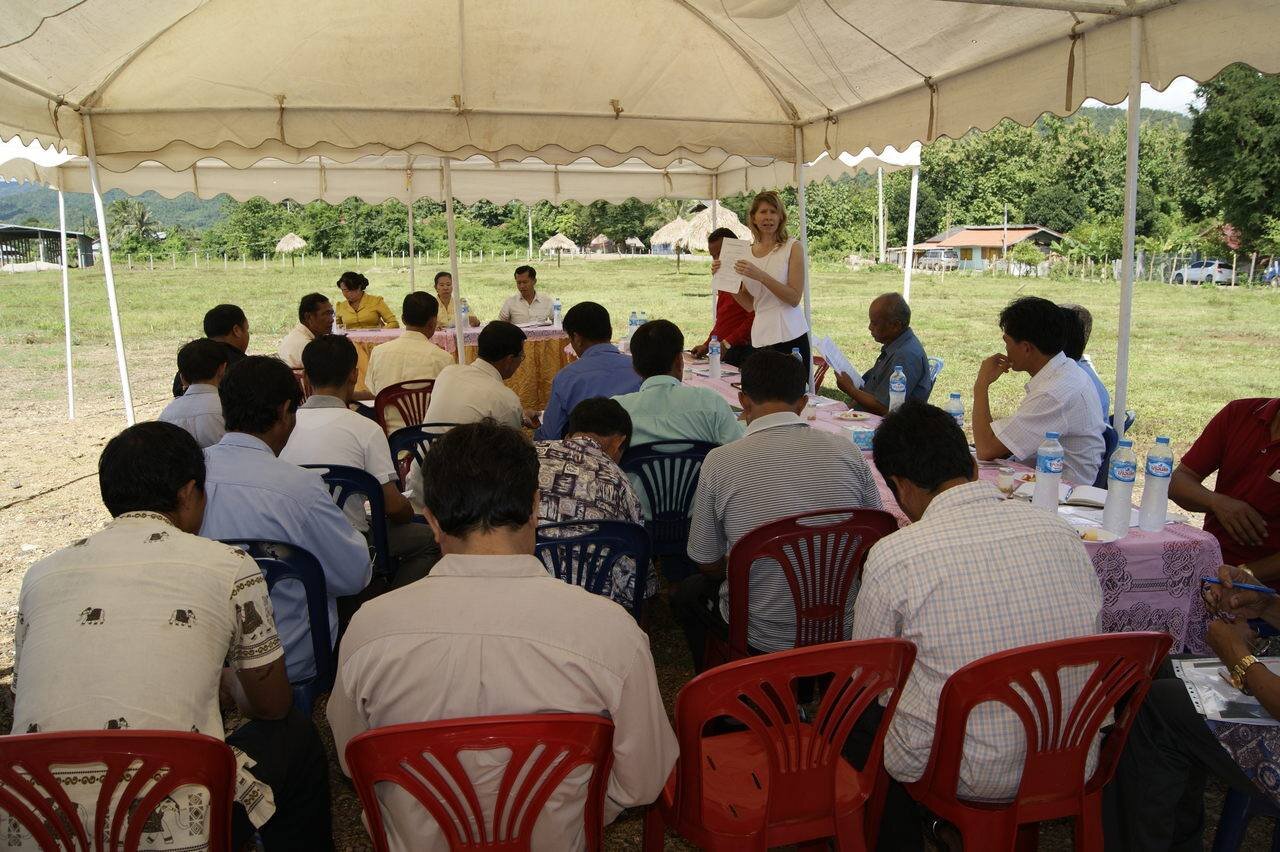
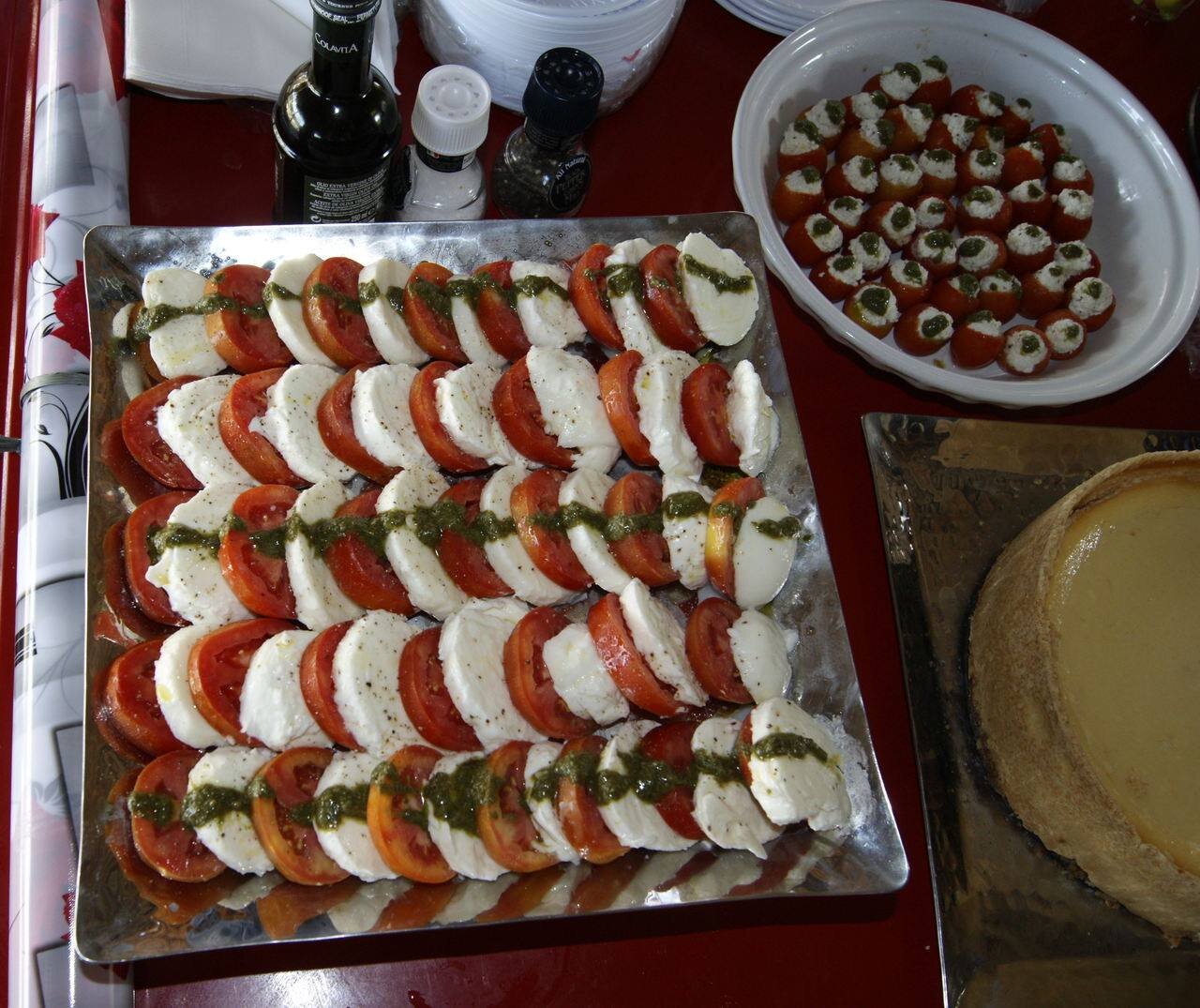
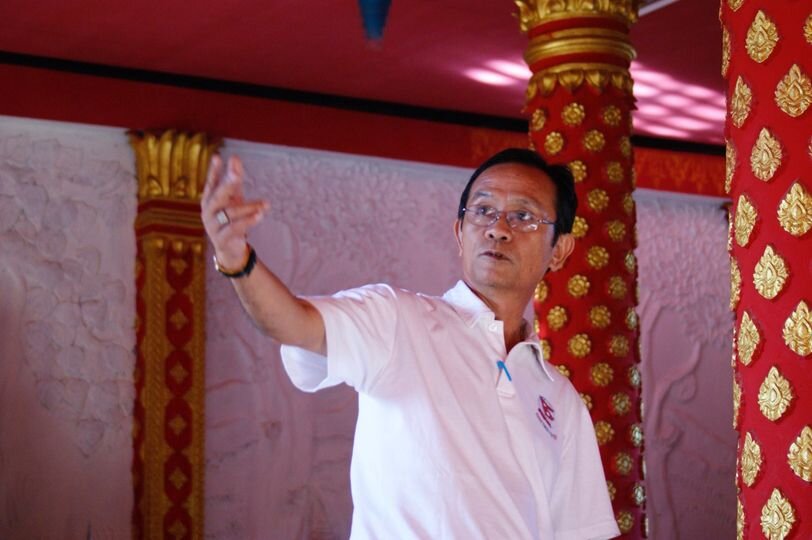
Talking with the Village Chiefs
For the next stage we brought the village chiefs to the farm and showed them what we were doing. We needed to get the village chiefs on our side before the farmers would agree to work with us. So, we set up a meeting, in October 2016, with 17 village chiefs at the farm and explained our new business and what it would mean for the farmers. We prepared yogurt, mozzarella caprese, ricotta stuffed tomatoes and cheesecake for the chiefs so they could taste what we would produce. We had Doctor Som with us, as well as other agriculture government officials, who helped explain and helped show them around. We talked about writing up a contract that is mutually agreed upon that each farmer would have to sign when they bring us their buffalo. Once all of that was set, our next step was to bring the farmers in.
Farmers Visit the Dairy
We arranged with the villages to come to visit the farm one village at a time, and they brought all the farmers who had buffalo. Every time they came we talked with them about what we were doing and how it would benefit them. Remember Mr. Eh and chief Somlit from earlier? Well they were some of the first people to have buffalo on our farm. This helped when the other farmers came. The farmers could see how the buffalo were handled by us and our team. They could see how healthy they were, and how much better the body condition was than the buffalo that were left to roam around unattended.
The farmers liked what we were doing but they were still skeptical about bringing their animals to us. They wanted to see their brother, cousin, or neighbor do it first to see the results. We understood that, it’s a lot to ask for their trust to do something when they have no idea how it will turn out. It’s like telling someone, give me your bank account and I promise I’ll return it in full with interest. Why would you trust that someone would do that? So, we needed to prove to them that it would be worthwhile.
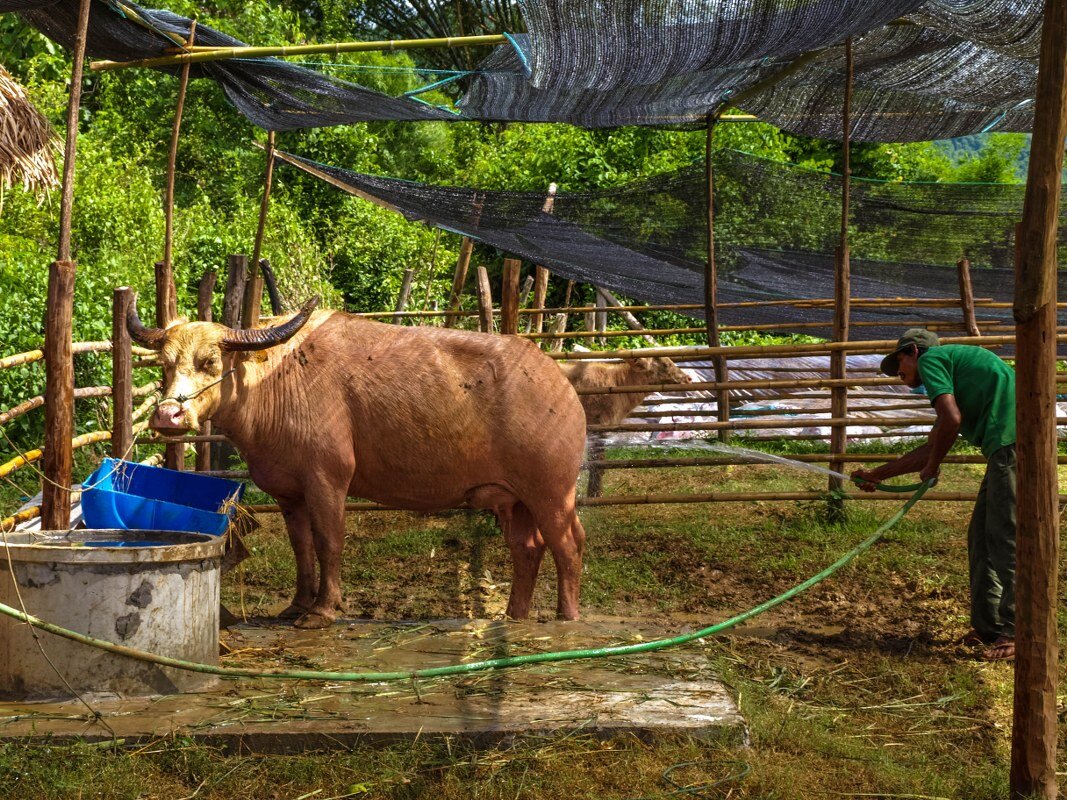
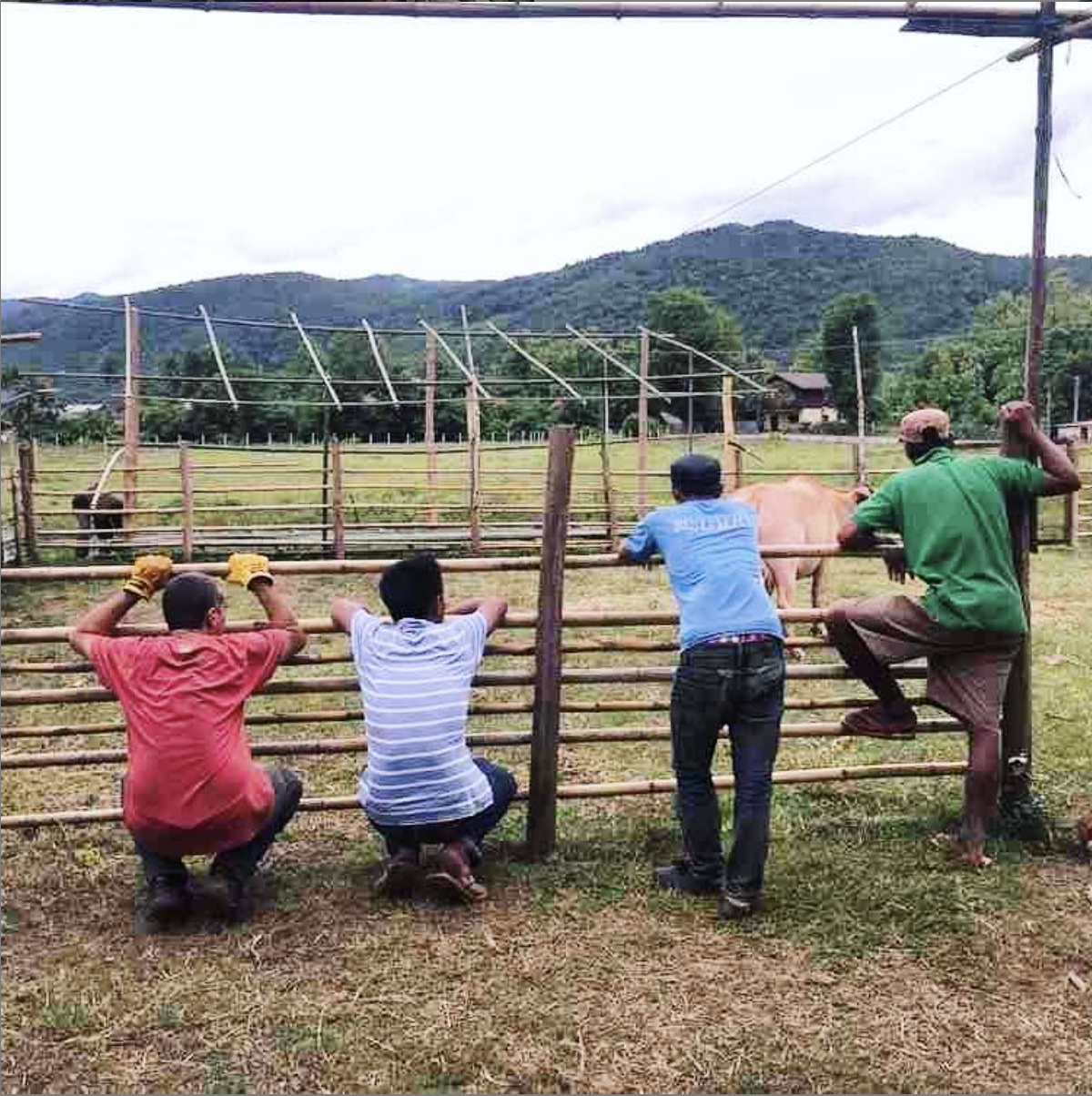
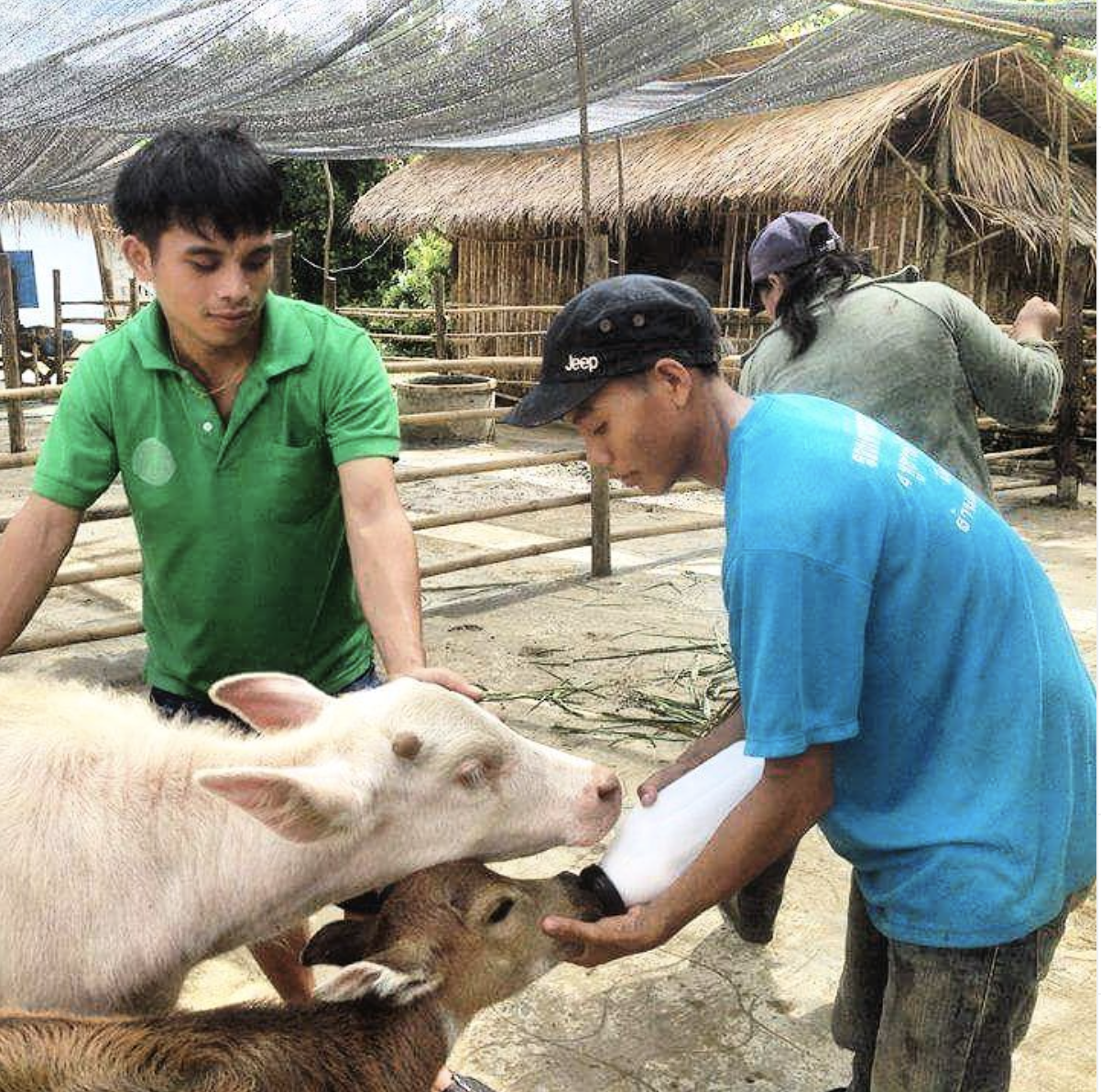
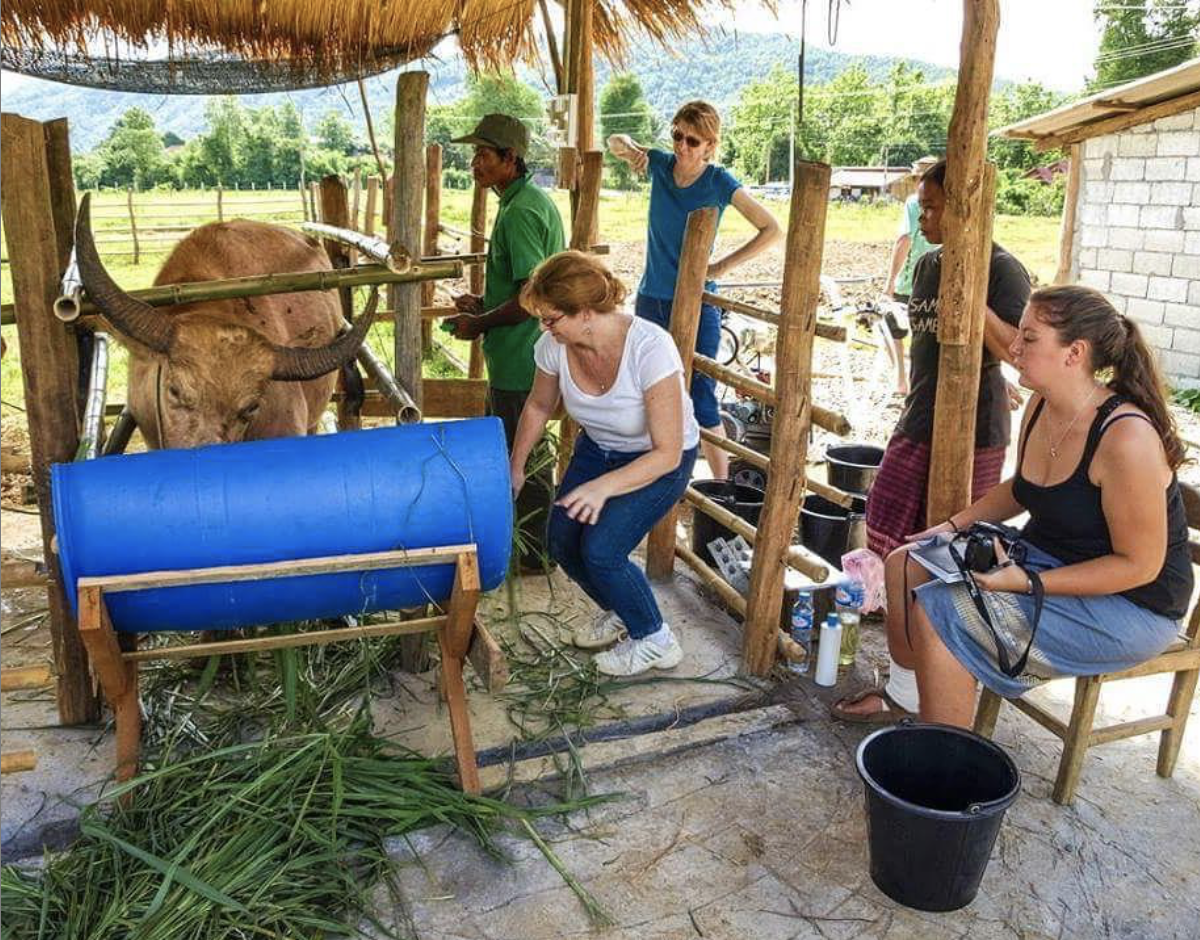
Uli and his Buffalo
A businessman in Laos, by the name of Uli had heard about what we are doing and he thought it was a great idea that would benefit the local people. He offered to buy pregnant buffalo to keep on our farm. That was a very generous offer and we were excited that he believed in what we were doing, but we needed to tell him we were not ready yet. The mini-farm was very rudimentary at this point and couldn't house that many buffalo.
He agreed to wait and we went about our business talking with people, feeding the few buffalo we already had, training a team, and just generally going about the day, trying to make things work. Then about two months later, we got a phone call from Uli – he had found a trader and bought nine pregnant buffalo and they should be arriving soon. That’s fantastic, but we still weren’t ready for them! This of course posed a problem as Uli didn’t have any land to keep the buffalo on. So, after some back and forth phone calls, he finally found a friend who was willing to take them for a temporary time until we could transfer them to the farm. This made us move faster. We needed to finish the mini-farm to take them.
But, we decided some other things needed to happen before the buffalo came to us. Like knowing if they were pregnant and how far pregnant they were. After an initial assessment, it turned out that of the nine buffalo he bought that were supposed to be pregnant, only four actually were. Uli sold the five buffalo who weren’t pregnant and we brought the other four to the farm to wait. One of these buffalo was to become our star, Lola! Thanks to Uli, we had some more buffalo to give us milk, but still not enough.
In the end, the reticence of the farmers to become involved caused us to do something drastic. In September 2017, we were still only getting about six liters of milk a day, as we only had a few buffalo on the farm. If we wanted to succeed, we needed more milk so we could make products to sell. We went to our friends at the Mini Murrah Farm just outside of Bangkok, Thailand and we arranged to buy 12 pregnant Murrah buffalo from them. On 26 September 2017, our pregnant ladies arrived on the farm. It was quite a to-do to get them off the truck too. You could tell the team was a little hesitant with these big beasts – they are much bigger than the local swamp buffalo. We tried telling them in Lao to move off the truck and then in English, but it wasn’t until a team member spoke to them in Thai that they actually moved. A good laugh was had by all, and our pregnant buffalo moved into quarantine for their first month with us. And now we had to wait for the calves to be born...
The Murrah heading to quarantine just after getting off the truck.
In our next blog, find out how our buffalo breeding program developed and meet the cute buffalo calves...
HAVE YOU SEEN OUR SOCIAL MEDIA THIS WEEK?
If not, pop on over to facebook/laosbuffalodairy or instagram/laosbuffalodairy to see what we have been up to!
TOURISM IN NEED
COVID-19 has badly affected tourism and visits to the farm. In order to mitigate some of the effects of the loss of income this has meant for the dairy, we have teamed up with the Tourism in Need initiative that supports responsible tourism organizations affected by the pandemic. Through this initiative, travelers can support the dairy through the Give Today, Go Tomorrow fundraising scheme. Click here to find out more and to make a contribution to help us to pay farmers and team members, and continue to train farmers and work on our nutrition program.
The Laos Buffalo Dairy Story: Part 1 - From Singapore to Mozzarella
In this week’s blog post chef Rachel shares our story as we tell it on the farm tour. We realise that while some people know about us, they don’t really know how we got here. Well, here goes!
In this week’s blog post chef Rachel shares our story as we tell it on the farm tour. We realise that while some people know about us, they don’t really know how we got here. Well, here goes!
Callie, Josh, Brie and Sarah on holiday in Borneo.
In 2013 our two families had a collective mid-life crisis. Susie quit her job, and a few months later, Matt quit his job. It was Halloween night in Singapore when Matt called me to say he had quit and was going to get a beer before coming home. At the time, I was walking down 42 flights of stairs with the kids and trick-or-treating. Talk about a time to have a mid-life crisis and a bit of a freak-out!
When I arrived home and told Susie what had happened, I asked her what we were going to do now, because I knew I certainly wasn’t ready to go home (meaning back to America). Susie suggested we go build a hotel somewhere and I agreed and thought we should go to Laos. Now, you might ask why a hotel and what could we possibly know about building one?? Well, Susie was regional GM of serviced offices with a head for numbers, marketing and staffing; Steven was an electrician and a construction manager in his old life; I was a chef and Matt was in finance. All four of us made a great team to start a project like this.
The next day we broke the news to Steven and Matt and told them our idea, and not even two weeks later, Susie and I were on a plane to go have a look-see at Luang Prabang. We had been to Luang Prabang to visit as tourists, but now we decided to go have a look to see if we might be able to go and move there for any opportunities and have a life there with our families.
Our buffalo curd & treacle breakfast in Sri Lanka.
While visiting, Susie and I decided to spend more money on food-related things than accommodation. One of the things we decided to do was to take the cooking class with Amantaka, a luxury hotel, and which included a field trip through the morning market with the chef. While walking through the market, we asked the chef where the buffalo curd was. Having been to Sri Lanka, and having had the curd every morning for breakfast while there, we naturally assumed that we would find it in Laos as well, considering how many buffalo walked around. He looked at us like we had three heads and asked, the what? When we explained it was a rich, creamy, thick yogurt made from buffalo milk and since there were so many buffalo, we thought they would milk them and make it. The chef stopped dead in the middle of the market and gave us a wide-eyed stare, while asking, “You can milk buffalo??”
Susie and I looked at each other and said, “Oh, we can do this!” And so, an idea was born.
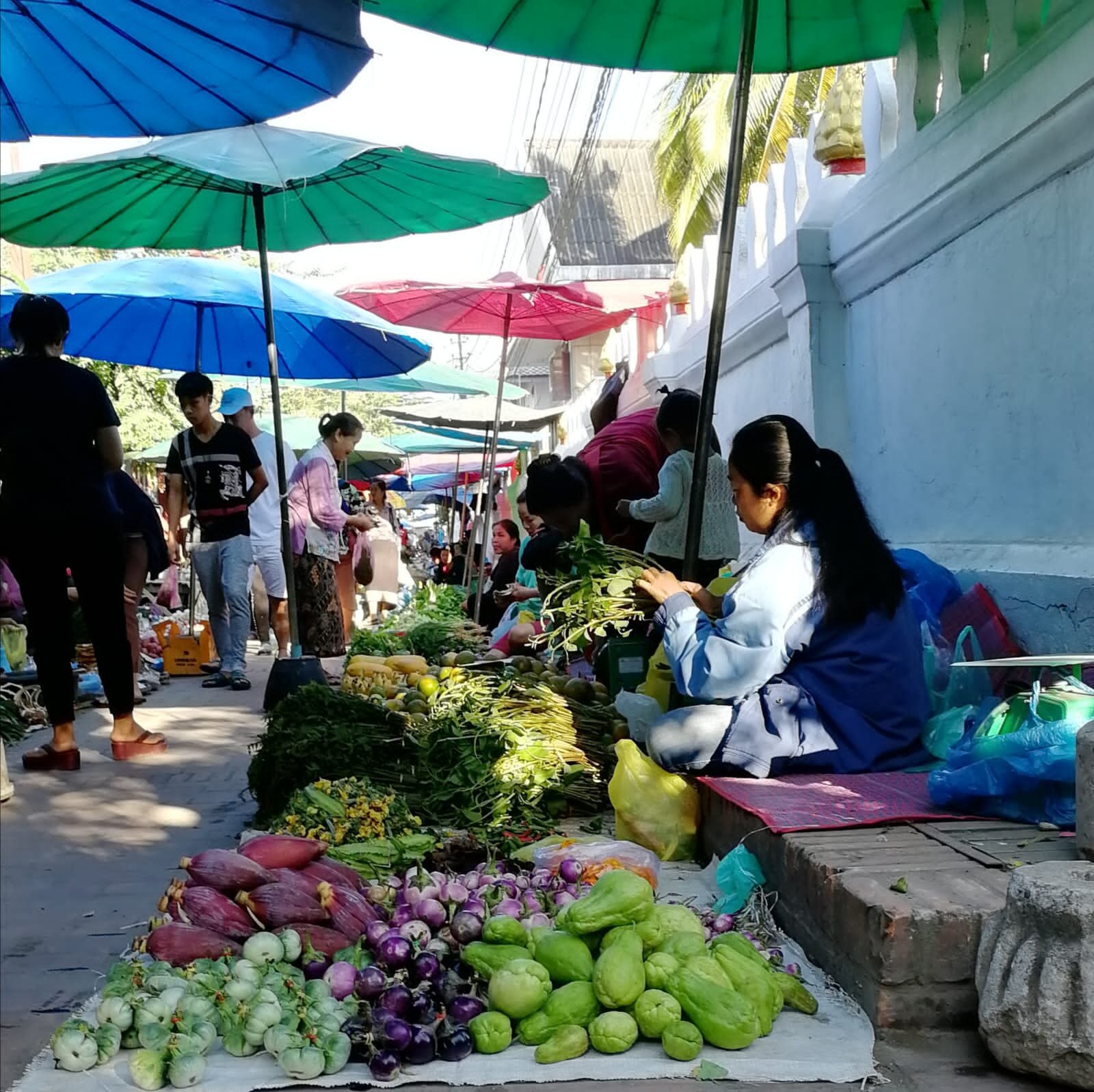
In January, the boys came back to spend ten days here. While here, Steven and Matt managed to find a guesthouse we could rent so that we could be hands-on on the ground and see how things worked. In August of 2014, Steven and Matt and the kids moved to Laos first to find houses, start running the guesthouse – Merry 1 - and get the kids settled before the school year started. In September, Susie and Rachel followed. Two days after Rachel moved to Laos, Matt moved to Hong Kong to start a new job.
When we first arrived, we had made a list of things that we thought the city could use – a real estate agency, large hotel, dairy, and some other ideas as well. Within the first few weeks we had a conversation with a friend about some of these ideas, but said that we thought the hotel should come first. The idea was always to design an eco-hotel, get the land and the licenses and then sell to the highest bidder, sit back, relax and play with the other ideas.
What a great idea! Only, it wasn’t to be that way. Two months after our arrival, our friend called us and said he had a farmer who was willing to work with us on milking buffalo. Oooooohhhhhkkkkaaaayyyyy….. so I guess that means we’re switching lanes.
Off we went to meet with this farmer and started to chat with him. We had to explain where milk came from, as it turns out that since there is no dairy culture here in Laos, most people thought that milk either came from a box (the UHT milk they are familiar with drinking) or from fruit – like coconut. We had discussions about how you could milk buffalo, just like you milk cows and showed him videos of people in India milking buffalo.
During the month and a half that we had discussions with him, we had a guest staying with us at Merry 1 that turned out to be more helpful than just a guest staying with us! One morning when she walked into reception, I looked at her and had a funny thought. I said to Maria, “Do you, by any chance, have any dairy knowledge?” Maria gave me a very shocked look and said, “Actually, yes, I do! I worked on a dairy farm for ten years, and I’ve been in dairy finance for 15!” I was so excited, I blurted out, “You’re my new best friend!”
Maria sat down at the desk with me, and I explained that we had an idea to start a buffalo dairy farm. We had a farmer that we were beginning to work with, and we needed help writing out directions on how to milk buffalo. She told me that she had never milked a buffalo, but she had milked cows and it couldn’t be all that different. After some discussion on how to do it, she promised that she would write up instructions in a step by step list for us, that we could then go and get translated into Lao. She was also interested in meeting the buffalo, as one of the things that she warned us about, was that if the buffalo were anything like cows, they weren’t very friendly with strangers and what we wanted to do might be very difficult.
With the translation done, we called the farmer again to go and see him and do some more explaining. This time he asked if we wanted to meet the buffalo. And of course, we said yes! We asked Maria if she would be interested in coming along since she was our milking specialist at this point and could be there to help answer any other questions the farmer might have as well. She was excited to come with us and meet the buffalo to gain a better idea of whether what we wanted to do would even work.
When we arrived, the farmer walked us into a little field he had nearby where he and his neighbor kept their buffalo. He told us that he had one tied to a tree as this one was kind of testy and didn’t like anyone, so he wanted to make sure we were all safe. Let me tell you it was a bit intimidating walking into that field with those big animals, having never been up close and personal with a buffalo before!
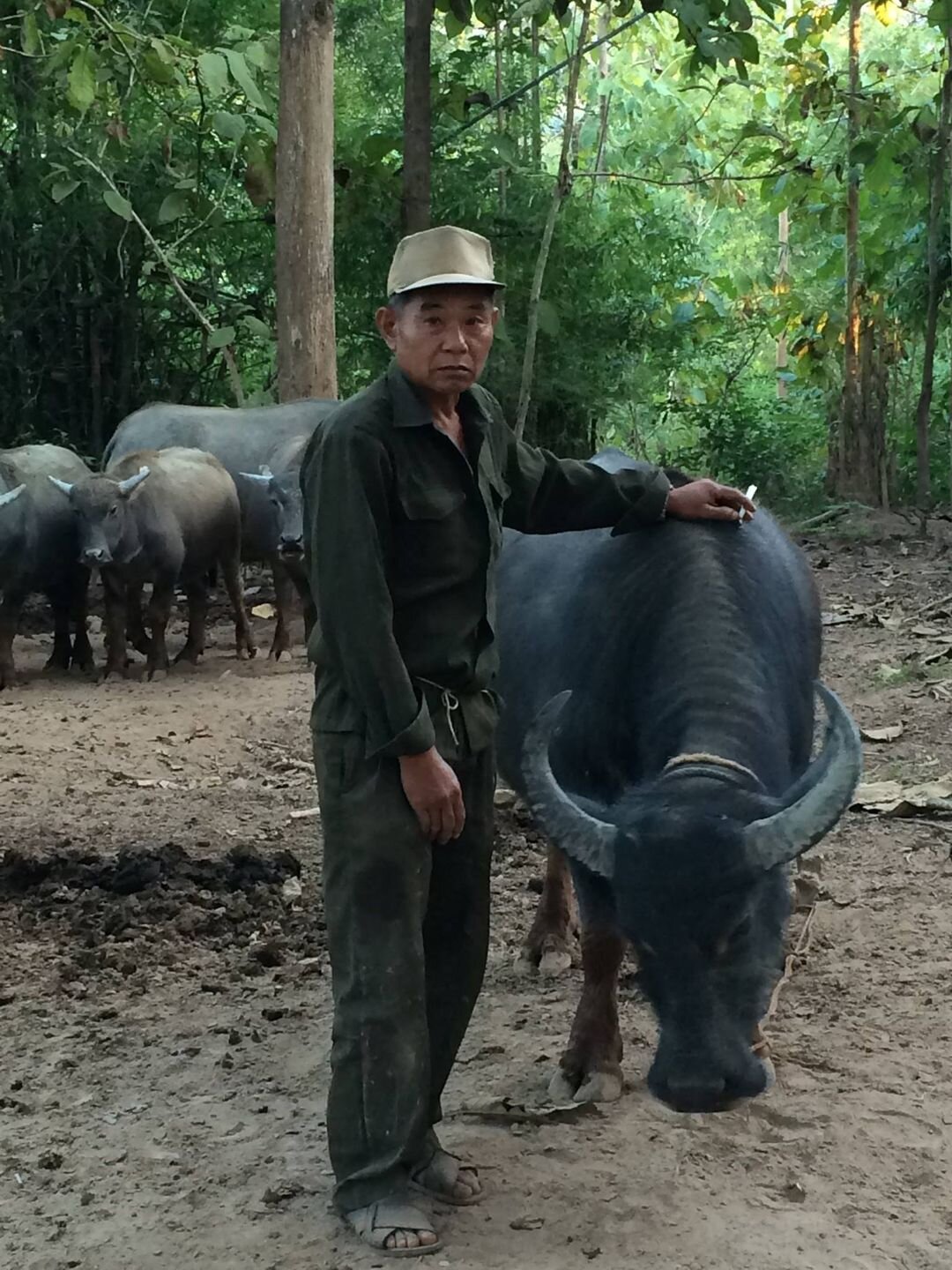


As soon as we entered, the farmer walked right up to one and started to scratch it on the butt. Its tail raised immediately, which we soon learned was a sign that it was enjoying what the farmer was doing. Before long, surrounded by curious buffalo, I was getting a bath by buffalo tongues! When the farmer noticed this, he asked if I wanted to stay with the buffalo as it was clear they liked me. Thank you, but no thank you. ☺ Maria was surprised at the curiosity and calm nature of the buffalo and decided that we wouldn’t have a problem at all if most buffalo were like this.
At the end of the day, we were happy and thought we could start a successful trial….. Until…. We received a phone call from the farmer, and he asked if the baby still needed to be drinking milk from the mother for this all to work. When we answered that yes, that was key to the trial, he told us that that had stopped a month ago. We thanked him and said we would see him next time around when the babies are born.
Being stalked by a buffalo…..but isn’t she cute???
At this point, we decided that we had invested quite a bit of time into what we were trying to achieve and that it was worth sending our team members out on a search to find another farmer who might be interested in working with us. It took about six more months, but finally, we came across Somlit, the village chief in Ban Thinkeo. Somlit is an outside the box kind of guy, and we love him! We spoke with him a few times and explained what it was that we wanted to do. We sat with him and some of his villagers to describe the milking and why it would be good. After some discussions, Somlit told us he would find us a farmer with who we could work.
Finally, we sat down with Mr. Eh, one of the villagers, who had three buffalo with calves that ranged in age from 2.5 – 4.5 months. We talked about the 6-week trial we’d like to do. We explained that we would need to build a fence with a separate pen for the calves and that while they were penned and separated, he would need to feed and water them. This approach was a big deal as in Laos, farmers generally cannot afford to feed, vaccinate, or pen in their animals, so they allow them to roam free looking for food and often wandering in areas where there may be diseases that could harm them.
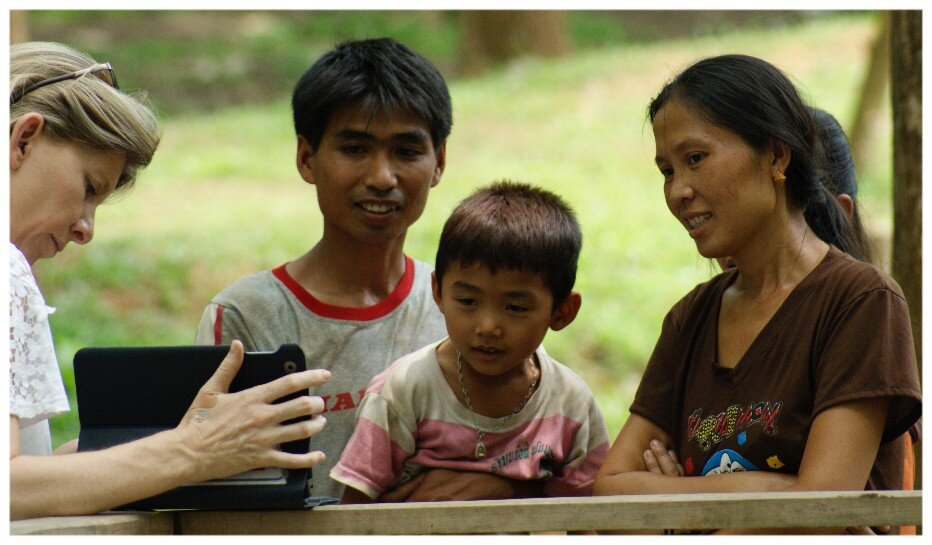

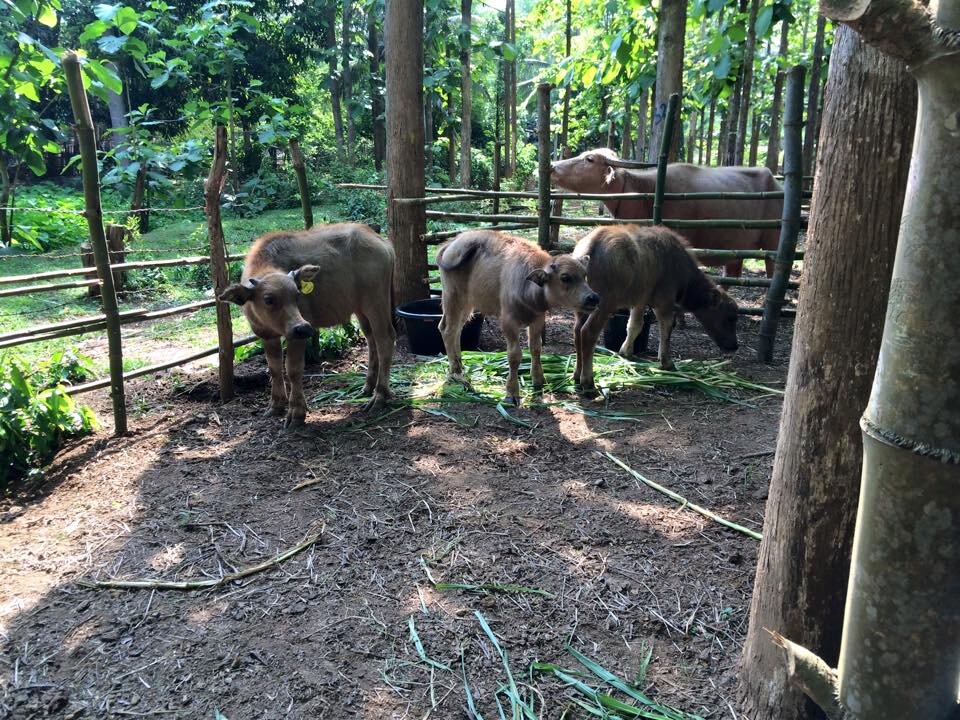
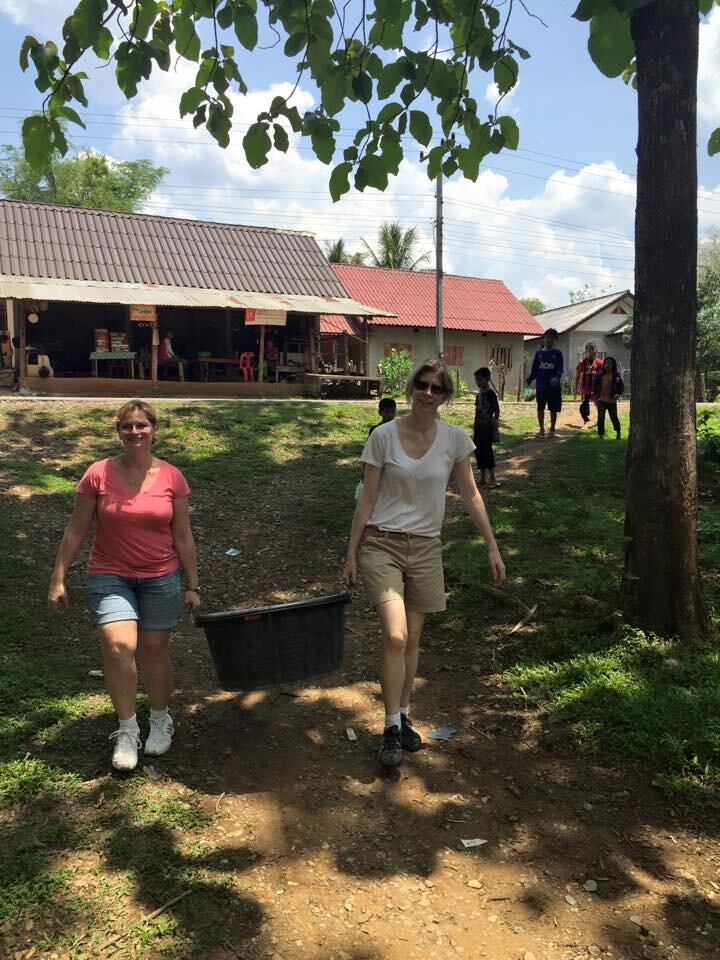
We looked at an area he had under some teak trees where he already had a pen of sorts built and then discussed how it would need to be changed a bit and reinforced. And add in a crush that we will be able to get the buffalo into securely so we can milk her. We explained that she would be more amenable to milking if we fed her at the same time and we would need to build a little trough as well. We bought the supplies to do it all and like Captain Picard, on Star Trek instructed, “Make it so!”
Once the buffalo were penned and separated, we started to milk or at least tried to milk them. It took a bit of time for them to get used to what we are doing and produce any milk. Having never been handled like this, we needed to teach Mr. Eh and his wife how to do it, since it was their buffalo and they were more accustomed to being handled by them. We were very excited when it worked. We had already talked with Mr. Eh about how the milk needed to be kept cold after milking until we could pick it up. And this posed a problem in the beginning as most people in Laos still do not have refrigeration in their homes, but they do have big coolers that they fill with ice. We supplied him with containers to milk into and store the milk – a separate one for each buffalo so we could keep track of how much milk they gave.
Steven as the “Caped Cheese Crusader” flying by to go get milk.
Steven drove out to Thinkeo every day to collect the milk and bring it home to me. Every 3 to 4 days, I had enough milk with which to experiment. And every 3 to 4 days, I tried to make cheese and cried. Why did I cry? Well, it was impossible to find cheese recipes online for making buffalo milk cheeses. There were very few people out there who made buffalo milk cheese and those who did, did not usually share their recipes. So, having never made cheese before, I was using a cow’s milk recipe to try and make it work for buffalo milk and adjusting after each new batch to try for a successful trial. Only, the composition of cow’s milk and buffalo milk are very different and do not react the same way with the ingredients, hence the tears.
I finally decided after days (more like weeks!) of crying and failing, that I needed help! I looked online and found all of the dairies worldwide who made buffalo milk mozzarella and emailed them all with my plight. Of the 15 dairies that I emailed, only one replied. And that was Thea from Shaw River Dairy in Australia who emailed and offered help. In her email, she told me that she could give me her recipe but that it won’t work, which of course stops me right there and I burst into tears yet again! But as I read on, she explained that the differences in fat in the milk plays with the ingredients, and I would have to adjust accordingly. I had an “aha!” moment and realised that I could work with this. So, I compared the recipes, with where I had started, where I have gotten to and with what Thea gave me, and I tried her recipe first. She was right, it didn’t work, but it did get me a lot closer. With a bit more adjusting, I finally perfect a mozzarella ball, just as we finish our 6-week trial. But, at least now we know that we can get milk from the local swamp buffalo and that I can successfully make mozzarella!
Next time...Building Laos' first ever dairy in Luang Prabang!
Here at Laos Buffalo Dairy, we are proud to be recognised at the prestigious WTM World Responsible Tourism Award in the Neighbours and Employees category. The awards this year were a little different as the judges decided to commend businesses and destinations which are taking responsibility and addressing the many challenges of Covid-19.
We won the award for the work we are doing to support the local Laos communities in and around Luang Prabang by setting up the first Buffalo Dairy in the country. The dairy is a popular and growing tourism attraction, and when Covid-19 hit all the income from tourists went away. Instead of shutting up shop, we re-imagined how we could continue to support our staff and the local communities.
Below is what we have been doing to keep local people employed and how we have been using our facilities to help our neighbours cope with Covid-19.
Staff
The dairy continues to employ all its regular staff, all of whom come from the local villages and, although payments have been reduced, all staff still make over the minimum wage. Also, free housing has remained available to any staff if needed. Free English classes for staff continue, meaning the chance to upskill for when Covid-19 is over. For any of the team with children, there is free buffalo milk to improve family nutrition.
Community
In the wider community, we have continued with the nutrition programme we have been implementing. The programme involves pilot projects in four local villages to research the best ways to increase nutrition, and implement improvements with resources already available to villagers. Issues with nutritional concerns will not go away with Covid-19, so continuing to work out the best practice in this area will allow us to roll out the programme on schedule, after reviewing the pilot stage.
Also, as part of the nutrition programme, we continue to expand and diversify from being solely a buffalo farm. During Covid-19 the first two cows arrived at the farm, and recently we acquired our first goats as part of our project to create a goat haven. All of these actions continue to help support the local rural village communities in a time of need.
Instead of cutting back training, the dairy is also continuing a farmer training programme to help the local villages.
Initially, we supported 17 villages and increased this to 20+ communities, all of which continue to receive support during Covid-19.
Free English classes take place on-site, and between 30-50 local children attend these elementary classes. Besides this, during the school holidays, the dairy teamed up with other responsible tourism organisations (Traditional Arts and Ethnology Centre, MandaLao Elephants and Free the Bears) to create a week-long English Language Summer School programme. The scheme allowed around 30 children from the local villages to attend English lessons, and visit these local tourist attractions.
The dairy has built a children’s play area that the local children can come and use every day (Monday-Friday). Up to 20 children use this facility each day.
To increase domestic tourism, we refocused on the local market, and for 50,000 Laos Kip ($6) we offer a tour of the buffalo farm. The money paid can also be used against any purchases in the cafe and is sufficient to cover three scoops of ice cream per person.
All of these programmes could have stopped due to Covid-19. However, it is a sign of the spirit, determination and commitment to our vision that we found a way to continue helping the local communities and loyal staff.
Coming soon!!!
The Little Book Co
We've got exciting news! We've been invited to have a page in a new coffee table book featuring inspiring stories of female business owners and change makers!
The book is going through pre production now and should be available by mid November. Keep your eyes on our next newsletter for more information!
HAVE YOU SEEN OUR SOCIAL MEDIA THIS WEEK?
If not, pop on over to facebook/laosbuffalodairy or instagram/laosbuffalodairy to see what we have been up to!
Lily's Story - Our amazing, cuddly cutie pie
If you have been to the farm or you follow us on social media, you know that we have two cats called Cracker and Lily. Today’s story is all about Lily so, don’t tell Cracker or he will get jealous 😊.
Lily was a rescue(d) cat! It all started back in June 2018, during the rainy season when after some serious rains and flooding, we were on our way home from the farm in the tuk tuk one day when we saw something in the middle of the road. Khamla swerved around “it” and we realized it was a little kitten. We pulled up to a stop, with Susie saying, “No, no no!” the whole time as we already had quite a few cats a home. As the tuk tuk stopped and we got out to go at least move her off the road, she looked at us over her shoulder and turned to come running at us. As I reached down to pick her up, she cuddled up onto my shoulder and purred like crazy.
We walked around the edge of the road and looked to see if we could find a mother cat nearby or other kittens thinking maybe she had just strayed away from them, but we found nothing. She was such a tiny little thing that we couldn’t in good conscious just leave her there. So, we took her with us. I stuffed her inside my coat to keep her warm, as it was quite chilly from the rain, and she cuddled right in. She must have known that her life was about to change for a better that she could never imagine.
Lily came home with us that night and got a bath – she desperately needed it as she was very dirty. She was fed some milk and food, and came to bed with me. From her size, we estimated she was only about 7 weeks old. Way too little to be away from her mother, so I guess we were mum now.


We luckily had Nicola, a vet, who was here in Laos working with Sydney University on a project, coming to the farm in the next few days, so we asked if she could have a look a Lily and make sure she looked ok and also confirm our thoughts on her age. Nicola confirmed her age for us as approximately 7 weeks old and told us that her fat little belly was probably full of worms. Not an issue! A worming tablet was given and all would be right with the world.
At the time, we had another cat at the farm as well – Kiara. Kiara was also a rescue cat, but she had been found in our chicken coop (also at about 7 weeks old). Kiara, now being about a year old, decided to take on the roll of mother cat and started to teach Lily how to act.
Lily flourished under the tutelage of Kiara and became cat extraordinaire. She learned how to hunt and play and be a smooch for affection.
Fast forward to now, and every morning when we arrive at the farm, Lily comes for her morning snuggles and purry cuddles. She helps to keep the mouse, rat and small snake population on the farm down to a minimum. And she walks the farm checking on the other animals to make sure all is good. On occasion you can find Lily following along with the guests on a tour. If we ever leave Laos, she has most certainly earned herself a passport out with us.
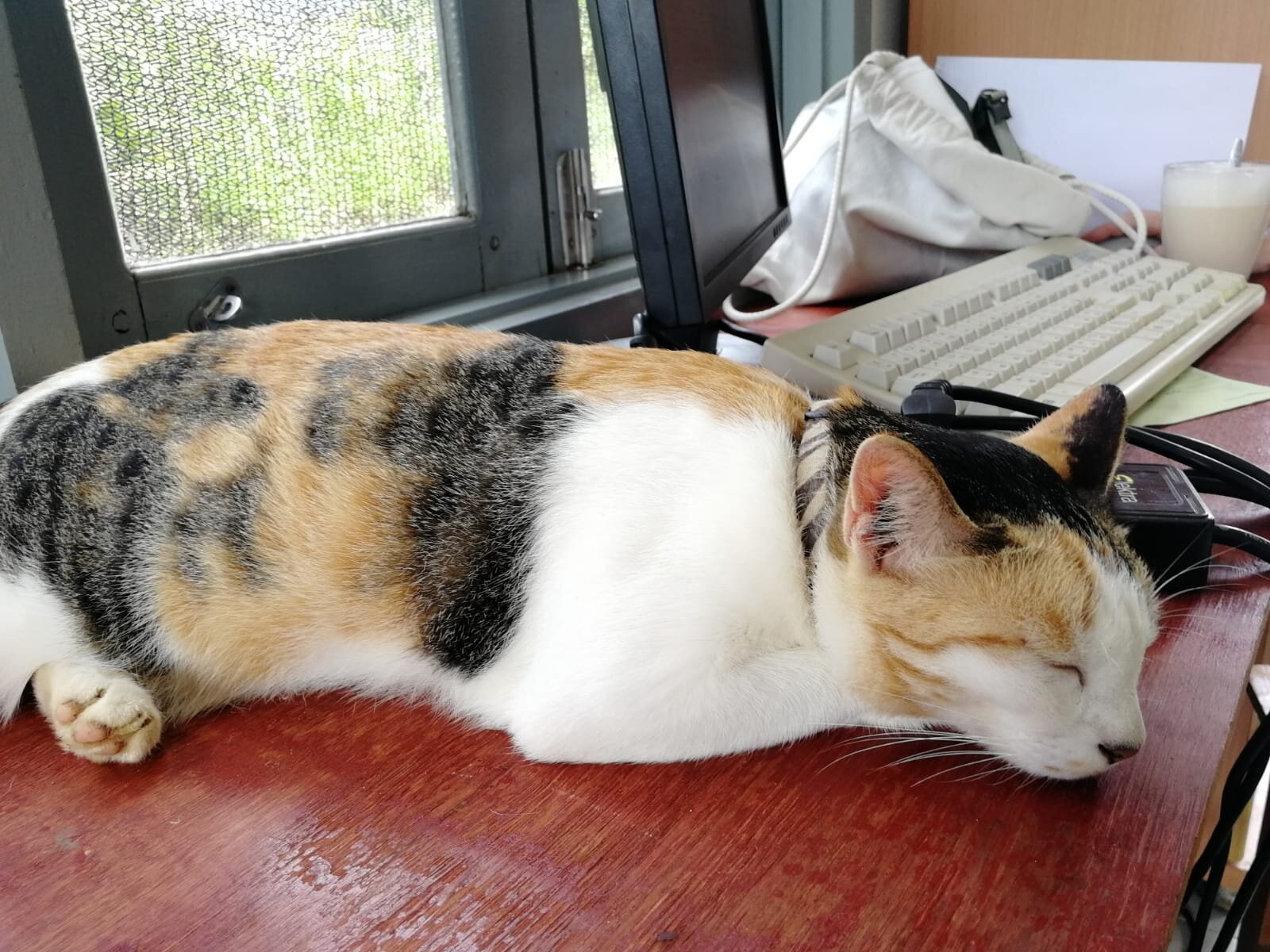
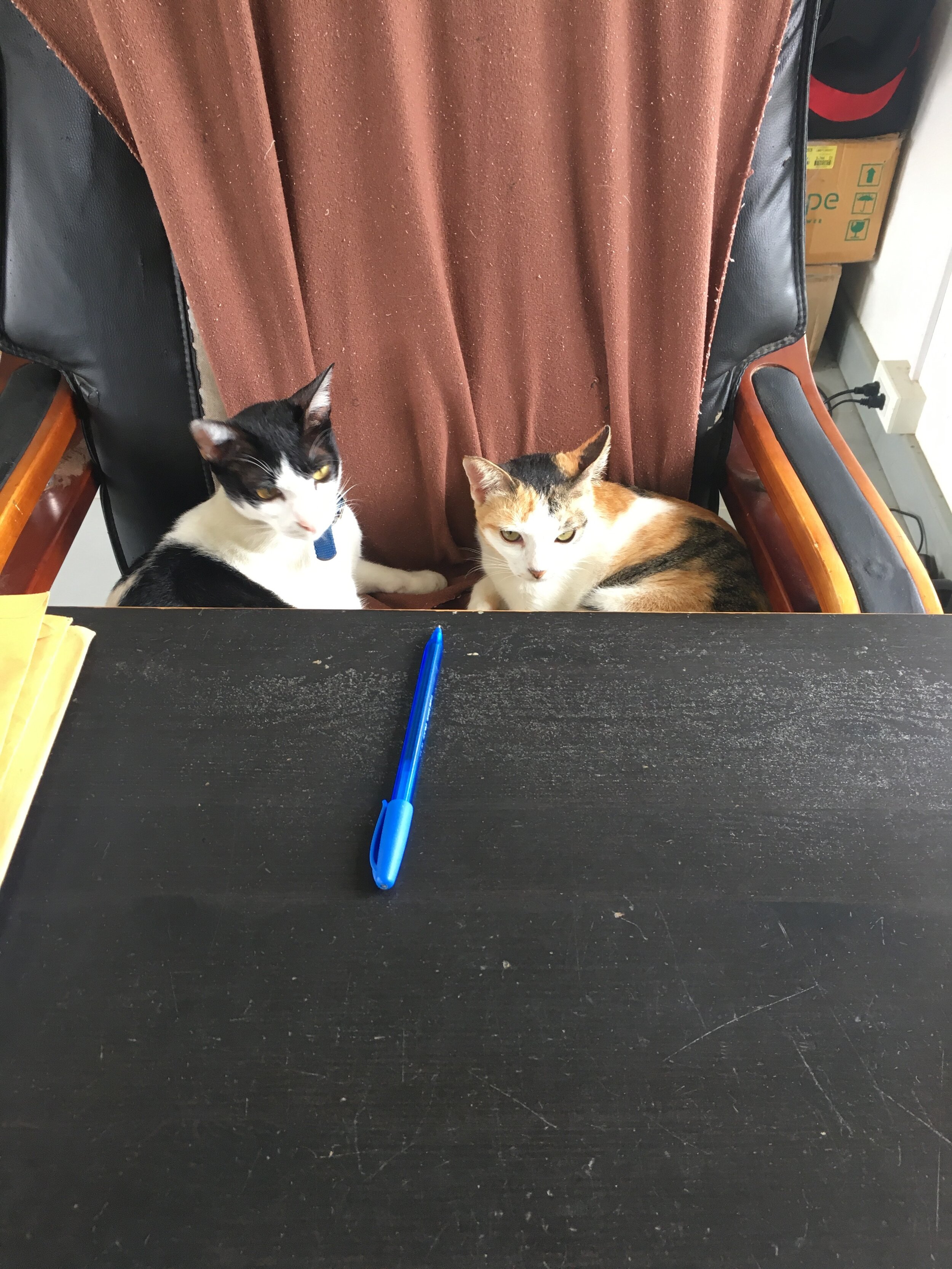
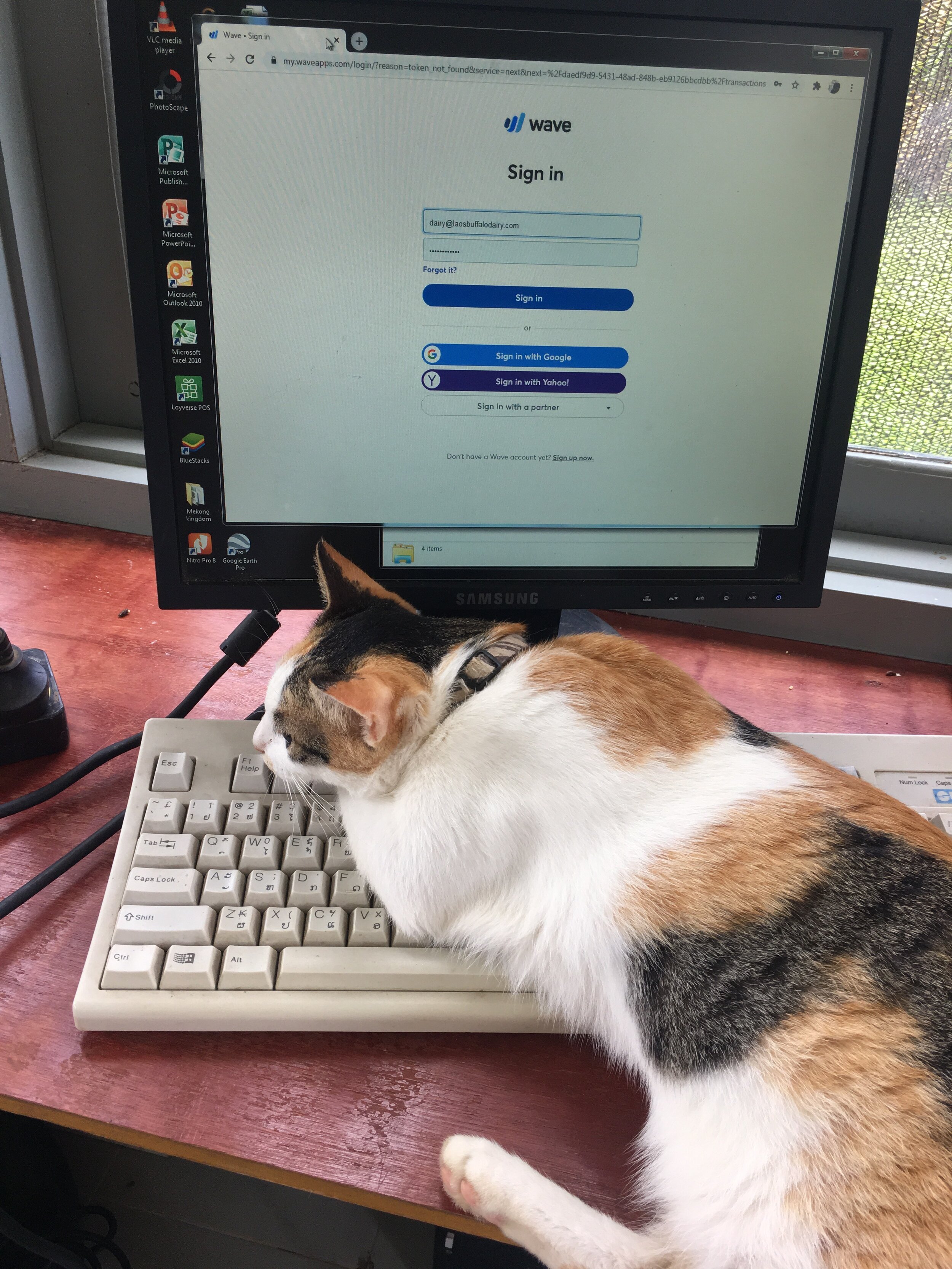
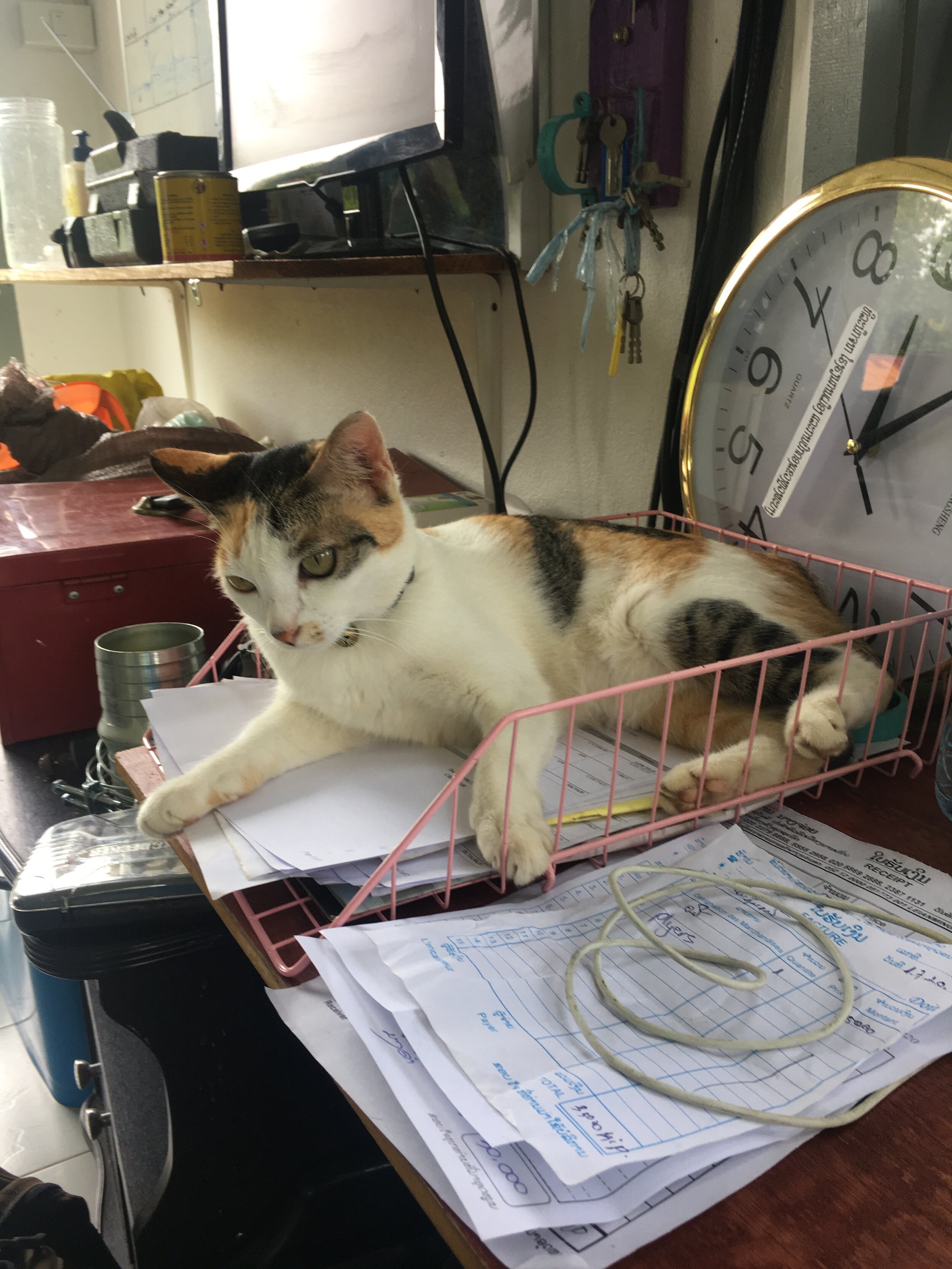
As you can see from some of the pictures, Lily’s favorite place to hang out in is in the office. Lately, with the lack of tourists coming to pay attention to her and Cracker, she has taken to “getting in the way”. Lily decides when the work day is done, but placing herself squarely in the file box or across the keyboard as I try and work.
Lily and Cracker are making do with seeking attention from us, but they’d really like to see you come back to play with them.
TOURISM IN NEED
COVID-19 has badly affected tourism and visits to the farm. In order to mitigate some of the effects of the loss of income this has meant for the dairy, we have teamed up with the Tourism in Need initiative that supports responsible tourism organizations affected by the pandemic. Through this initiative, travelers can support the dairy through the Give Today, Go Tomorrow fundraising scheme. Click here to find out more and to make a contribution to help us to pay farmers and team members, and continue to train farmers and work on our nutrition program.
HAVE YOU SEEN OUR SOCIAL MEDIA THIS WEEK?
If not, pop on over to facebook/laosbuffalodairy or instagram/laosbuffalodairy to see what we have been up to!
Coming to Luang Prabang sometime soon? Need suggestions on what to do? Pop on over to our Suggested Itineraries page and make a plan.
Pitching in for World Clean Up Day
On 22nd of September it was World Clean Up Day and some of the Laos Buffalo Dairy Team pitched in.
Millions uniting worldwide to call for a waste-free world!
On 22nd of September it was World Clean Up Day and some of the Laos Buffalo Dairy Team pitched in.
Millions uniting worldwide to call for a waste-free world!
World Clean Up Day happens only once a year, but try to remember daily not to throw garbage everywhere. Keep the planet clean, recycle.
Our ecosystems are being ravaged by waste and pollution. We must keep our beaches, woods, seas, rivers, countrysides and city streets clean – only then can our environment once again regain its health and beauty. To do this, we need a systemic shift in our approach to resources – drastically reducing the amount of waste created, and preserving all resources at their highest quality by reusing what we can, and recycling or composting everything else. We also need a collective consensus on creating a healthy waste-free environment for all. We must shift our perspectives, and treat all waste as a precious resource - just like nature does. It’s only waste when it’s wasted.
The Laos Buffalo Dairy: Sustainability in action
Whatever image comes to mind when you think of Laos, a beautiful sparsely populated nation in Southeast Asia, delicious cheese probably isn’t one of them. Yet in 2014 when a mid-life crisis propelled Rachel O’Shea, Susie Martin and Steven McWhirter to leave their expat postings in Singapore and settle in beautiful Luang Prabang, cheese was definitely on their minds.
Although buffalo milk is very nutritional—it’s actually higher in calcium and protein than regular cows’ milk and lower in cholesterol too—these cheese-loving aficionados soon realized that in this land chock full of buffalo, a dairy industry was non-existent.
Whatever image comes to mind when you think of Laos, a beautiful sparsely populated nation in Southeast Asia, delicious cheese probably isn’t one of them. Yet in 2014 when a mid-life crisis propelled Rachel O’Shea, Susie Martin and Steven McWhirter to leave their expat postings in Singapore and settle in beautiful Luang Prabang, cheese was definitely on their minds.
Although buffalo milk is very nutritional—it’s actually higher in calcium and protein than regular cows’ milk and lower in cholesterol too—these cheese-loving aficionados soon realized that in this land chock full of buffalo, a dairy industry was non-existent.
Read more: https://www.impactresolutions.ca/single-post/The-Laos-Buffalo-Dairy
Travel vlog from Laos
Each day a lot of wonderful people visit us and we are very grateful for all the positive responses we get from you guys!
Sometimes stars from The voice cross our gates, other times vloggers that discover Luang Prabang. Check out this video about our beautiful city. Starting 3:30 you will be taken on a virtual tour around Laos Buffalo Dairy
Enjoy!
Each day a lot of wonderful people visit us and we are very grateful for all the positive responses we get from you guys!
Sometimes stars from The voice cross our gates, other times vloggers that discover Luang Prabang. Check out this video about our beautiful city. Starting 3:30 you will be taken on a virtual tour around Laos Buffalo Dairy
Enjoy!
Featured in Portfolio magazine
Another accomplishment for all of us here at Laos Buffalo Dairy. People from Portfolio magazine covered Luang Prabang in this month's issue and guess who's mentioned in there. Exactly! Your truly, Laos Buffalo Dairy.
Another accomplishment for all of us here at Laos Buffalo Dairy. People from Portfolio magazine covered Luang Prabang in this month's issue and guess who's mentioned in there. Exactly! Your truly, Laos Buffalo Dairy. The title of the article is "Heritage is serious business in Luang Prabang" and it covers a lot of aspects. From the ceremony of giving alms, the Mekong and food culture.
Since the issue is not online yet, we leave you with just a tiny piece of the article, the one where we were mentioned.
Veterinarian Specialist, AI and Babies Abound!
This has been very busy few weeks at Laos Buffalo Dairy. Our international veterinarian specialist from Holland, Ronald van Giesson has been here helping us with all of the buffalo and procedures on the farm.
But that isn’t all! We were lucky enough to have a world-renowned buffalo specialist from Thailand, Dr. Ohm, come and visit us as well to help with an Artificial Insemination program for the buffalo
This has been very busy few weeks at Laos Buffalo Dairy. Our international veterinarian specialist from Holland, Ronald van Giesson has been here helping us with all of the buffalo and procedures on the farm.
But that isn’t all! We were lucky enough to have a world-renowned buffalo specialist from Thailand, Dr. Ohm, come and visit us as well to help with an Artificial Insemination program for the buffalo. The Laos government has been very concerned with the genetic inbreeding among the buffalo in Laos.
In 2014, they embarked on a crossbreeding program with swamp and Murrah buffalo to try and “get some new blood” into the herds. Laos Buffalo Dairy is now facilitating that program on our farm.
Dr. Ohm and Ronald helped us with the program in order to start our next round of Artificial Insemination. Dr. Ohm came loaded with an ultrasound machine for us to use to see if any of the buffalo were currently pregnant before we started them in the program. Can we tell you how excited our team was to have a look at the ultrasound pictures and see the babies moving inside the mums? We even managed to bring the machine to one of the local villages to check some of their buffalo and show the farmers what they were looking at. We caused quite a stir!
The rest of the buffalo will go through a regime, similar to what humans would go through, in order to help bring them into heat so we can perform AI on them. But, as a backup, we will also be putting them together with our bulls. You can never be too safe!
Laos Buffalo Dairy is now looking into a portable ultrasound machine for the farm so we can keep a closer eye on new babies and buffalo health! We can then also possibly go into some of the local villages and help out with reproductive health for their buffalo.
There are a lot of new and exciting things happening on the farm! Keep your eyes open for what comes next!
Don't forget to follow us on Instagram, Twitter and Facebook for more news!
Pregnant Murrah arrive & a new baby buffalo
After months of going back and forth between Laos and Thailand, selecting the right buffalo, making sure the birthing dates would be right, and filling out paperwork, out beautiful buffalo ladies from Thailand have arrived!
(For those of you who don't know what Murrah means, is a breed of Water buffalo :) )
After months of going back and forth between Laos and Thailand, selecting the right buffalo, making sure the birthing dates would be right, and filling out paperwork, out beautiful buffalo ladies from Thailand have arrived!
Recently 12 pregnant Murrah buffalo arrived at Laos Buffalo Dairy. These ladies will be added to our family to help up our milk yield and hopefully, help us breed more Murrah/Swamp cross breeds which we can then populate the Laos countryside with.
These ladies will live together in a quarantine shed for a full month so we can make sure they don’t have any diseases that they could pass to our Laos population. After that time, they will join the rest of our crew and live the spoiled life of a milking buffalo. The babies are expected to come into the world in the next 4 – 8 weeks and we can't wait to meet our new little babies!
Keep a lookout for our baby pictures! We know you’ll love the cuteness as much as we do!
Also, on the same day the Murrah arrived, one of our own local buffalo gave birth. So much cuteness and good news in just one day!
We are making burrara. Wait, what is burrata?
So... Rachel started making burrata and when she proudly told us we had no clue what that was.
But do not upset the chef, seems like she knows what she is doing. After a short google search we all were: aaaa, burata, sounds absolutely delicios! Now we can talk about it. Yes please, make some more.
What is burrata
You might still be asking. Basicaly mozzarella, but creamy and runny when you cut into it. The recipe goes something like this:
- you take some of the curd before you stretch it
- chop it up
- mix it with cream
- and make a pancake of more curd
- put the chopped curd inside like a purse.
Everyone had to taste the delicious burrata and we all were really pleased with it. It's great for breakfast, in salads and milion other combinations.
We drooled on this recipes and hope that our dear Rachel will test them all!
And also, if you are in Luang Prabang on the 15th of July, we plan to participate in the market in the gardens at Sofitel. We will be selling what we have that night.
Have you ever try burrata before?
Buffalo Selfies
Life at the farm has some nice perks! One of them is having so many cute animals around us all the time!
Since July lots of selfies were taken so we decided this should be a trend. So many types of selfies out there, none of them with a buffalo?
The initiator was definitely Stephen, who took the 1st buffalo selfie on our first milking day!
Life at the farm has some nice perks! One of them is having so many cute animals around us all the time!
Since July lots of selfies were taken so we decided this should be a trend. So many types of selfies out there, none of them with a buffalo?
The initiator was definitely Stephen, who took the 1st buffalo selfie on our first milking day! You can read all about our adventure with milking the buffalo here.
The crew jumped in, of course!
Our fist buffalo selfie
Buffalo baby kisses!!!
Matt's Buffalo Selfie
And along the way more and more people started taking a #buffaloselfie.
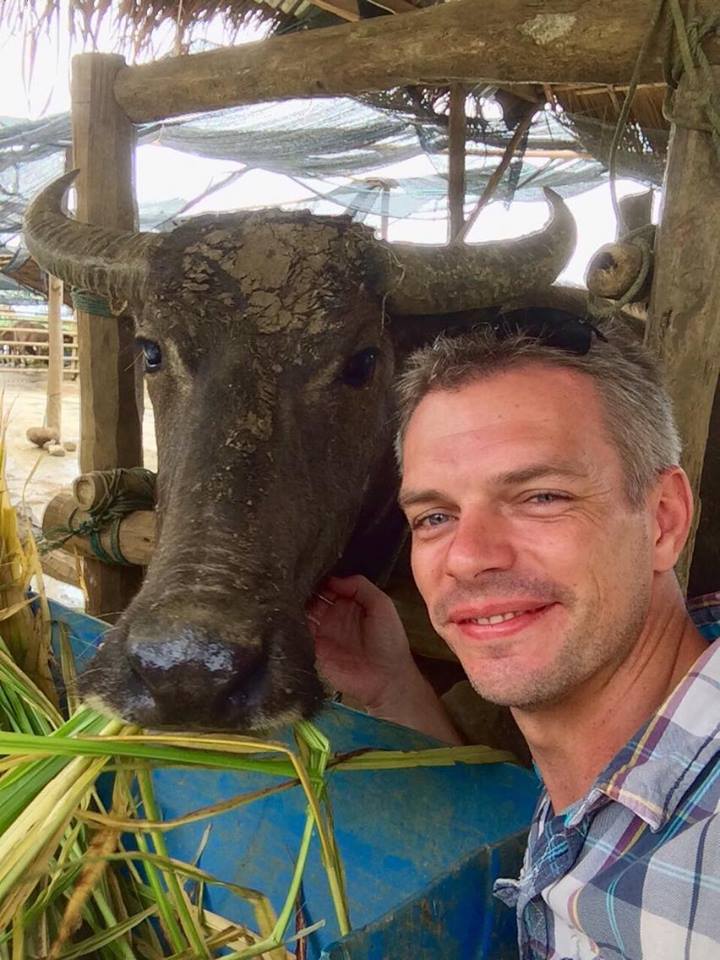
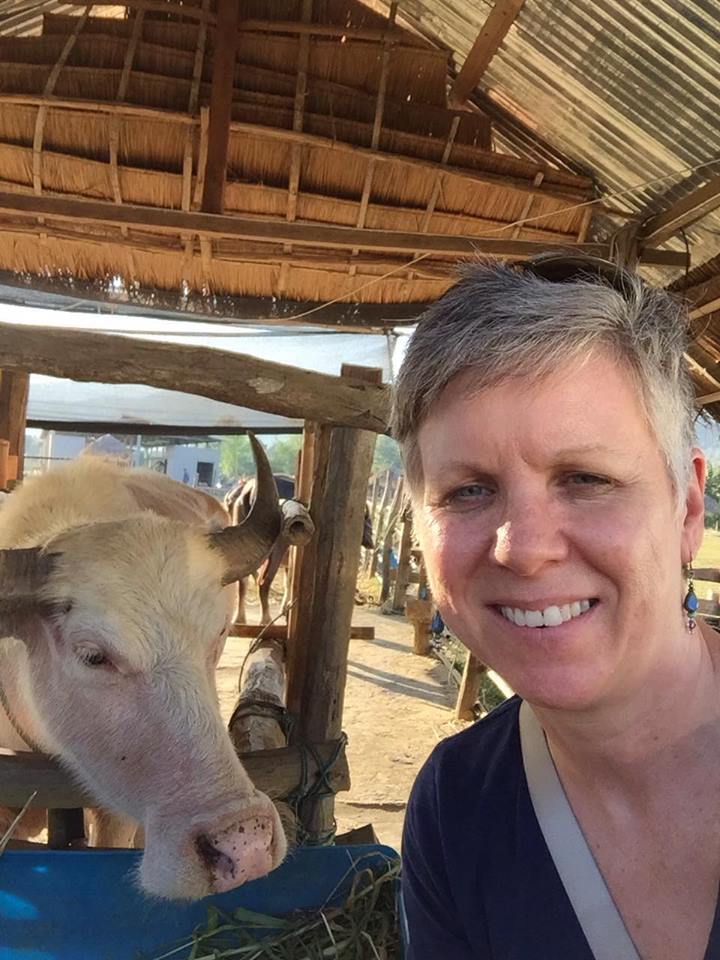
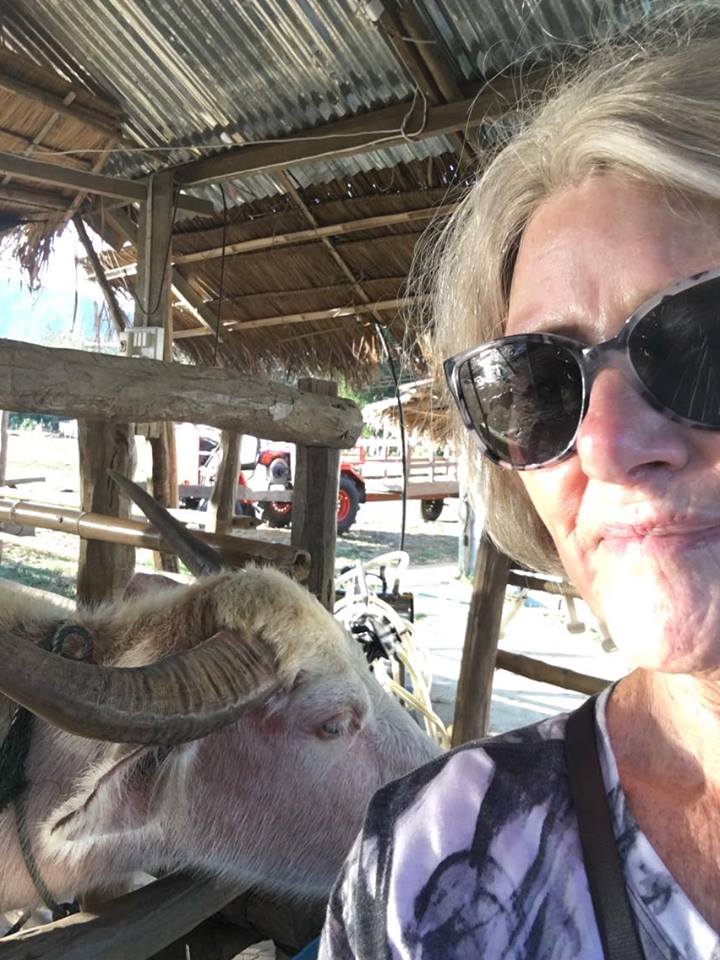
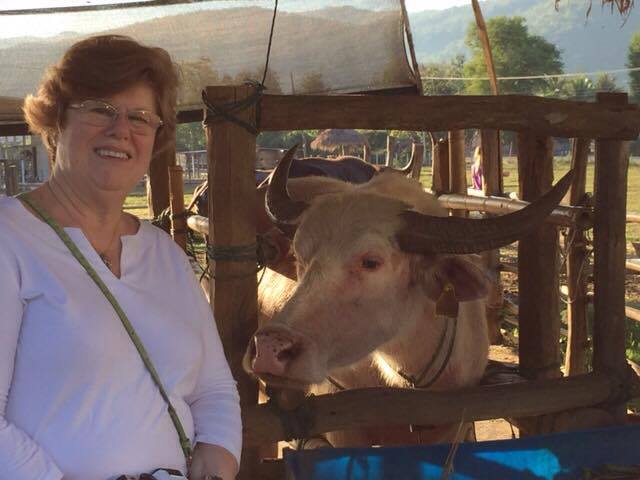
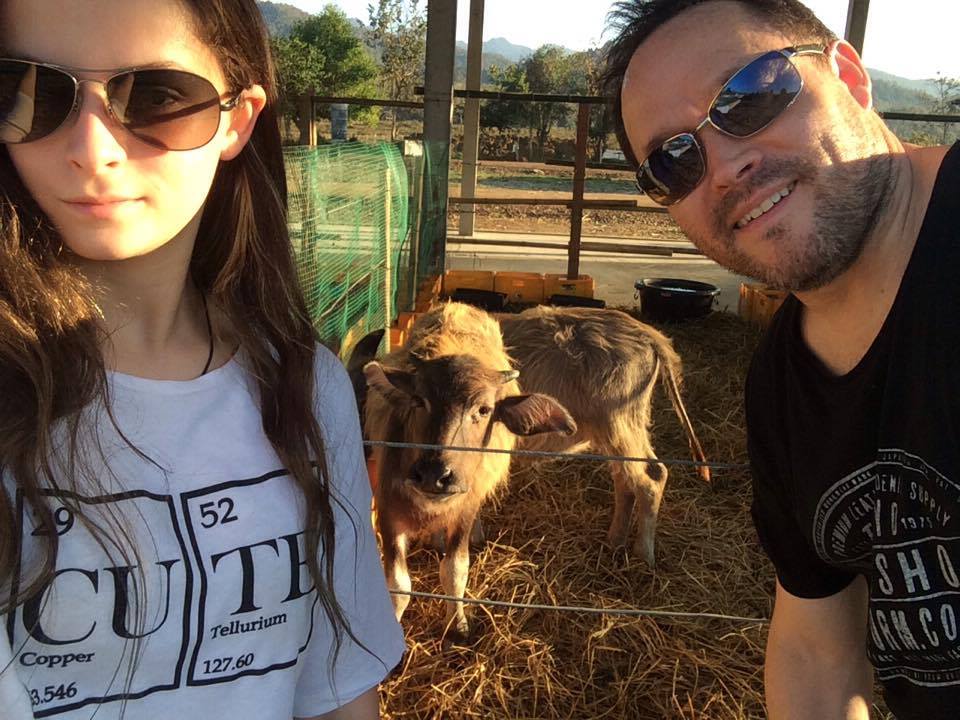
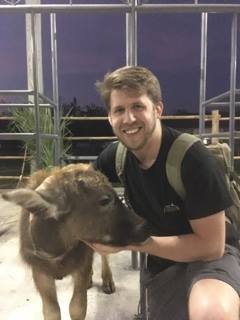
So if you visit Luang Prabang don't forget to drop us a visit, take a selfie and use the hashtag #buffaloselfie!
Well, to be honest, the most important thing is have a nice afternoon, play with our calves and enjoy our delicious dairy products!
Thank you for following us on Facebook, Twitter and Instagram!
Laos Buffalo Dairy – Meet the Neighbours and Fact Finding tour!
So what happens when you want to start a dairy but have very limited experience? You try and find as many people as you can, to help you get off the ground!
We were extremely lucky to find a buffalo dairy just outside of Bangkok, Thailand with a wonderful owner by the name of Runchuan, who owns Murrah Buffalo Dairy, to take us around her farm and answer any and all questions that we had. Our trip was set up by Somsak, from Dairyinterline in Bangkok and he played tour guide and translator for us. This was actually Somsak’s first time meeting Runchuan as well.
So what happens when you want to start a dairy but have very limited experience? You try and find as many people as you can, to help you get off the ground!
We were extremely lucky to find a buffalo dairy just outside of Bangkok, Thailand with a wonderful owner by the name of Runchuan, who owns Murrah Buffalo Dairy, to take us around her farm and answer any and all questions that we had. Our trip was set up by Somsak, from Dairyinterline in Bangkok and he played tour guide and translator for us. This was actually Somsak’s first time meeting Runchuan as well.
The dairy is situated about 2 hours outside of Bangkok, so Somsak met Steven and I at our hotel at 9:30am and drove us out. Slowly, thru morning traffic, we managed to leave behind the hustle and bustle of the city life and it became a little more country-like the further we traveled. Somsak treated us to lunch in a little village not far from the dairy since we were a bit early and afterward a coffee at a little local shop. All the while, discussing with Steven plans we had made for the milking and cow shed designs.
After a deliciously filling lunch of local Thai food, off we went again to find the dairy. At this point we were only about 30 minutes away.
In we drive, to fields on our left and fields on our right growing grasses that we can only guess are meant for the buffalo. Finally we come to an opening and see a big house up ahead. As we get out of the car, a woman walks out of the house and approaches us. This is Runchuan. She apologizes almost immediately in Thai to tell us that she doesn't speak English and she will need Somsak to be her translator. Steven and I apologize right back that we don't speak Thai. And then she tells us that we have come at the right time as the afternoon milking will start soon.
We wander down a dirt road leading away from the main building and all of a sudden the view opens up and there are lots of buildings to house buffalo. Runchuan is working with about 400 ria of land and she has about 200 buffalo but only 60 are currently being milked.
As we walk further in, we come to the first pen which holds about 30-40 buffalo and has a nice big wading pond for them to enjoy. Only non-milking buffalo are afforded a wading pool, as you don't want any contamination for the milking buffalo. The structures she has built are very rudimentary but they are very functional. Being in an area where the weather doesn't get very cold or snowy, there is no need for walls in the winter, so the structures are basically metal posts, concrete and dirt floors and a roof made out of corrugated tin. The water troughs are large and made from concrete and have pipes leading out of them so they can be drained and cleaned as needed.
We walk around the farm from pen to pen looking at all of the different buffalo and all of the sets ups. She has a mixture of swamp buffalo, Murrah buffalo and a few other types that she cross breeds. Interestingly, we find out that it takes 3 generations for the horns of the swamp buffalo to curl in (and become less of a hazard to humans when you are trying to move around the buffalo! :-P). This is an important piece of information for us to have as the majority of the buffalo we will have in the beginning will be swamp buffalo and we are cross breeding them with Murrah.
Finally, we walk on and find the pens that have the milking buffalo in them and along side them we see the babies! And as we walk up I have to laugh because right in the middle of the pathway is a playpen set up with a few babies in it. I turn to Steven and giggle and say, “I had a playpen just like that for my kids when they were little! I never thought I'd see buffalo calves in a pen like that.”
We stand here for quite a while as there are a good many things to see at this juncture. Runchuan tells us that even with all of the land she has, she is unable to grow all of the fresh grass herself that she needs to supply the number of buffalo she has so she uses a dried mix. In front of us there are large plastic barrels that hold the mixture and a conversation ensues between Somsack, Runchuan and Steven about what she uses and how she stores it. As this is outside my purview, I wander over to the babies and stroke a few noses and take some pictures. They are very cute in a bouncy sort of way and remind me of my youngest child with their bounciness.
I watch as the milking mothers are led into the milking area. They seem to be happy following each other right up the ramp, head to bum, all the way. Runchuan tells us that since these mothers don't get a wallowing pond they get a nice long bath before being milked. Her system is set up so that there is a shower that comes down on each buffalo as they stand in line and another that sprays from the bottom up. As they stand there in the shower, a farm hand walks around them with a hose and hoses them down even further.
As we walk through the center of the building, we look at the ramp and structure that the buffalo have come up. It is basically a horseshoe shaped structure that allows for the first batch of buffalo to come in to be showered and then a gate is opened for those buffalo to continue to walk through to the next gate which stops them in the milking area. Here also, the buffalo stand head to bum in a line, on just a slight angle. This system is called a herringbone system. The buffalo are up on a platform and there is a trench dug on the outside so the workers can stand and easily attach the milking machines to each buffalo. In this system it takes 15-30 minutes to milk 20 buffalo at a time, depending on how cooperative the buffalo are being.
Runchuan has 5 or 6 men attending the buffalo on the milking side. They give a final clean to the udders of each cow, make sure the cups stay attached, tie down legs where necessary if a buffalo gets feisty and tries to knock off the cups, and collect the milk. The milk is collected in plastic buckets and wheeled over to the “boss”, a woman who sits at a table above them with a clipboard and a scale. Each bucket is emptied thru a sieve into another bucket on a scale. The men tell the woman which buffalo it is and she records the amount of milk at each milking each day. Then she pours the milk from that bucket into a big milking urn.
After watching the milking process, we went back up to the main house where Runchuan had had a table set for us so we could try some of her products. She gave us some warm buffalo milk to try as well as mozzarella and a butter that she has been trying to develop. They were all very tasty treats for the afternoon.
After these treats, Runchuan asked us if we wanted to go out and see her tourist part of the farm. Of course we said yes! About 40 minutes from the actual farm, she has a beautiful site. At her other site, she has ducks and chickens, bunnies, goats and pigs and most of all, she has buffalo!
School trips and the general public can go in and see the Baby buffalo and some mums as well. She also has a restaurant set up too. She gave us some of her soft serve buffalo ice cream and I got to make a pizza. She does classes for kids and adults here using her cheeses and milk. Inside the restaurant is a gift shop where you can not only buy her cheeses and milk but you can also buy buffalo-y gifts. She also has a line of skin care products that she sends her milk out to be turned in to. If her products are anything like the feel of our milk on the skin, I'm sure they are a huge success!
All in all it was a great day. Very informative and lots of fun (and filling!). It's definitely a place we need to go back and take the kids next time. I'm sure they will love it!
Lights, camera, action
The phone rings and Lathsavong, Dairy Manager announces that the government would like to come and visit the Dairy tomorrow. In Laos there can be a fair amount of government bureaucracy to satisfy with any business let alone a new industry, so not quite understanding the harassed quality to Lathsavong voice I ask what time they’re due to arrive, thankfully it’s tomorrow afternoon. We have the career fair at the Northern College of Agriculture starting at 8 am tomorrow but if we leave at lunchtime we should be able to make it the 90 mins over to the farm in time for their arrival. So unconcerned am I, that Steven, the Dairy General Manager is having a well earnt day off the next day and asks if he should attend. No, No that won’t be necessary!
The phone rings and Lathsavong, Dairy Manager announces that the government would like to come and visit the Dairy tomorrow. In Laos there can be a fair amount of government bureaucracy to satisfy with any business let alone a new industry, so not quite understanding the harassed quality to Lathsavong voice I ask what time they’re due to arrive, thankfully it’s tomorrow afternoon. We have the career fair at the Northern College of Agriculture starting at 8 am tomorrow but if we leave at lunchtime we should be able to make it the 90 mins over to the farm in time for their arrival. So unconcerned am I, that Steven, the Dairy General Manager is having a well earnt day off the next day and asks if he should attend. No, No that won’t be necessary!
The career fair goes well (see Mobbed by the Crowd) and we start our journey across town with a quick stop off to pick up more yogurt and cheesecake having been cleared out at the career fair. Arrive 90 mins later, set up a table with some information on the Dairy and some product ready to go. The night before had seen torrential rain so whilst waiting for government we decide to help clear out the storeroom which had seen some water get in and unable to help myself, I proceed to re-arrange it. We have printed out signs in English & Laos to keep everything in its proper place, so that my mild case of OCD is satisfied. Job done, we now wait to see what time our visitors will arrive.
A few minutes later we hear cars approaching along the road and a convoy of cars complete with police escort passes the gates. We go to sit down again, however as we go to turn I notice the police escort do a U-Turn followed by the rest of the convoy, I say to Jennifer I think they may be coming back to us. Jennifer laughs no it couldn’t be ohhh it is, they are turning into the gate. A definite pregnant pause as we all look at one another with a “What do we do now?” expression across all of our faces.
At this moment all I can think is: thank goodness we had the career fair earlier in the morning so I am wearing my “Sin” traditional Laos skirt and good shirt as opposed to my usual wardrobe of jeans and t-shirt.
I, Lathsavong & Lam all line up – think receiving line at an event with the Queen or equivalent! The rest of the team all looking slightly nonplussed pause in whatever they are doing to see what they should do next. Very good question as we’re not quite what sure to expect at this point either.
The cars have now driven up our very muddy road and begin to disgorge their guests. We have the official staff of the Lao National Council, Livestock & Fisheries department, Luang Prabang Agriculture and Forestry; the Chief of Luang Prabang Livestock and Fisheries, Mr. Kanchan and then our guest of honour Deputy Director Lao National Council, Mr. Sounthone. Greetings alone take a good 5 minutes particularly as none of us are really very sure on the protocol of greeting this many people from the government!
The only “meeting spot” we have is a low table with tiny stools that the staff use when having lunch. Greetings over, we gather around the table, some on stools, some sitting on the railings and some standing, it’s quite a crowd! Lathsavong begins with a formal introduction of himself, me and the rest of the team, this could take quite a while! It then moves on to a laptop presentation with me holding the laptop so everyone can see. The noisiest things by far are the chickens who have decided that running around between everyone’s legs and under the tables is great sport – definitely going to be chicken soup at this rate!
Then proceedings pick up pace and it’s a whirl of activity as we head towards the milking area. Many questions and quite a few jokes ensue as we discuss milking and udders. The word for milk and breast are the same in Laos, so quite a few guffaws all around as our husband and wife team Boon Soon and Saw step us to begin the milking with Boon Soon being asked about touching boobs with his wife in the vicinity.
Next comes feeding our baby calves. The cuteness factor never fails and we soon have everyone jostling for a turn to hold the bottles. Then it’s on to taste testing the yogurt and cheesecake.
A few days later, there was another call from Lathsavong. Being “old pro’s” now we spring into action and have everything ready and everyone lined up for our next visitors. Dr. Bounkhuang KHAMBOUNHEUNG, the deputy minister of Ministry of Agriculture and Forestry of Luang Prabang province is our guest of honour today and have to admit it never gets old when your visitor has a police escort! He is also companied by various staff from the ministry and today not only do we have photographers we have TV. Sure enough after this visit we appear on the Laos News channel. One of our friends even took a photo of his TV screen to show us!
There is however a serious side and the government from both visits are very keen to understand more about the dairy and how everything works; the involvement of the farmers buffalo, how we will look after the buffalo and most importantly are very keen to know how they can help. It’s becoming apparent that they see our business as the beginning of a sustainable industry filling a real need in the market for dairy products that will also assist the local farmers through additional income, conserve buffalo and provide another attraction for tourists along the Kuang Si Waterfall road thus extending their time in Luang Prabang and helping to increase the average spend of tourists in the city.
Mobbed by the crowd
It all started innocently enough, a visit to the Northern Agriculture & Forestry College about 45 mins north of Luang Prabang to discuss partnering with the College for research & training purposes with their students. For an Agricultural College surely 200 buffalo being used for the 1 st dairy in Laos must be of interest!
It all started innocently enough, a visit to the Northern Agriculture & Forestry College about 45 mins north of Luang Prabang to discuss partnering with the College for research & training purposes with their students. For an Agricultural College surely 200 buffalo being used for the 1 st dairy in Laos must be of interest!
Sure enough there was a great deal of interest, in fact the College currently has buffalo on one of its many farms and they were quite keen to discuss moving them to our farm so they could have a larger herd size to study.
Then we started to learn more about the College and the types of programmes they offered, in particular;
- Agronomy – soil management and crop production
- Livestock & Fishery – animal husbandry, breeding and vet science
- Food Production – micro finance, marketing & agricultural products processing
And that in a few days’ time there would be graduation for those students who had finished the 3 year courses.
Would we be interested in attending the College Job Day so students could learn more about Laos Buffalo Dairy and perhaps we could find graduates interested to work with us?
Considering we have 20 hectares of land to grow grass for buffalo, 200 buffalo due to arrive by November and a kitchen being built to produce delicious cheese and yogurt, students who had respectively studied; agrimony, livestock and food production seem to fit the bill perfectly!
Of course we would love to attend, what did we need to prepare? Nothing to complex just; a sign up sheet for students – buy clipboards & don’t forget pens, power point presentation in Laos, projector (find projector), some of our delicious food – yogurt & cheesecake, necessary serving implements…
Then the question “how many students would be attending?” A few hundred, oh ok 1 cheesecake may not be enough – quick call to the chef who was actually flying to HK the next day – “please make a few more cheesecake”, Chef -“How Many” oh just a few hundred mini- cheesecakes! Chef – “insert expletive here” and as pushing my luck anyway, “please make a strawberry compote to accompany the yogurt”. Chef – well I’m sure you can guess what goes here!
Food now taken care of we run around in the two remaining days to put together the rest of our list. Day dawns and I literally mean up at crack of dawn. Coolers for the 12 litres of yogurt, compote and cheesecake, tablecloths, plates, spoons, power boards, back up computers, your basic pack mule scenario! Then off on the 45 min tuk tuk ride, stop for ice, warm yogurt not quite so delicious!
Arrive to find we have prime spot opposite the stage and graduate presentation area. Set everything up and then realise it’s too bright so impossible to see the presentation. Unpack table again move to another spot in the back row and re-set table up. At least we know where everything goes – go 10 rounds with the borrowed projector which belongs to our French friends – practice my school girl French with technical equipment – Yeah…
Then the fun began, students started arriving from their dormitories en masse, a sea of white and orange (teachers & administrators) shirts swelled towards the booths and us. Food always a draw, we have wave after wave of students keen to learn about this strange new business in Luang Prabang and try some new foreign food. Yogurt and cheesecake not featuring high in the Laos diet! The sweeter cheesecake went down a treat although there were a few grimaces for first time natural yogurt eaters, at which point we added some strawberry compote and the grimaces generally turned to smiles. It’s now only 10.00am and we start to run out of mini-bowls, Link goes for a quick jog to a little shop 10 mins away to buy more.
A moment of calm to wander around and see some of the other companies participating. Our friends from Blue Lagoon Restaurant, Luang Prabang View Hotel, The Living Land Company, Indigo Farm & Helvetas.
We even manage a few interviews with prospective employees one of whom, Bee goes on to receive an award later in the day and is now working for Laos Buffalo Dairy! We now have 2 graduates Bee & Khamlee working with us at Laos Buffalo Dairy and more soon to join.
As lunch begins we hand out our last cheesecake and 12 litres of yogurt have been consumed, questions about Laos Buffalo Dairy answered and a significant list of job seekers names collected! Thanks to the College and Dr. Outhai for all their help and support in what will hopefully be the 1 st of many career days Laos Buffalo Dairy attends.
So that was the morning, now off to our farm 90 mins away for a government meeting we found out about yesterday but that’s the next blog post...
Buffalo Wrangling
It has been just over two weeks since our first buffalo arrived. This was the beginning of our “mini farm”. The idea of our mini farm was to start our first few months with 5 buffalo so that we could train our staff, perfect our recipes, and get the word out about our business while our main farm gets built.
After all the excitement of getting our business started and getting our first buffalo, we still could not have imagined what we were in for once we got going.
It has been just over two weeks since our first buffalo arrived. This was the beginning of our “mini farm”. The idea of our mini farm was to start our first few months with 5 buffalo so that we could train our staff, perfect our recipes, and get the word out about our business while our main farm gets built.
After all the excitement of getting our business started and getting our first buffalo, we still could not have imagined what we were in for once we got going.
Getting our second buffalo was almost as hard as the first, but for an entirely different reason. One family in Muang Khay Village (where our dairy is) had always said they would like to rent us their buffalo, but that they wanted to be the second family just to make sure that other people were joining as well. Naturally, once we got the first buffalo, we called this buffalo owner and told him that he would now be second. He came and saw our farm, signed the rental contract and brought us the buffalo. The very next day, we went out to start milking our 2 buffalo to find that there was only 1 there again. We found out that the man’s wife had arrived and taken her buffalo back because she did not know about our company. We quickly backed away as the family quarrel started to rage. Thankfully, once we had a few more buffalo, the wife agreed and they brought their buffalo back together (and she is one of our best milking buffalo!).
Before we could have any doubts about how hospitable our land is, we learned the need to keep other buffalo off of our land. As we store our quality feed and are implementing strict health standards for our buffalo, it is imperative that no other buffalo comes on our land to steal the feed or cause any contamination. On one day, we had staff at one gate bringing in one of our new buffalo, while other staff members were chasing about 10 buffalo off of our land at the other gate. We have painfully discovered each weak fence post and every fence wire that was too short. Admittedly, it has been a useful sales pitch to buffalo owners that their buffalo literally can’t resist coming into our farm!
Part of the procedure of learning to milk buffalo includes separating the babies from their mothers and feeding the calves milk concentrate and roughage. We got adorable calf feeding bottles from a dairy in Bangkok and taught our staff how to make the concentrate. Our first day was a little pathetic, as two of our staff tried to feed the baby buffalo a bottle, while the calf ran away. After a bit of research that night, we realized we would have to be a little more aggressive. Our research said to try and straddle the calf and use one arm to turn the head back and the other to put the bottle in the mouth. After drawing straws of who had to do it, we sent our first staff member in, who basically tried to straddle the cow and was immediately thrown off. We slowly added more staff members until there was 4 people trying to hold the buffalo still while one person poured the milk in.
We had always known it was better to get the calves young, as it means more milk in the mothers and that it is easier to train the calves to drink from the bottle. We have officially learned that lesson the hard way, as our first two buffalo calves were already a month old. However, now these two easily take the bottle from just one staff, and drink it twice per day! It was that much easier to put the next three calves on the bottle, as they were much younger (and cuter!). Raising buffalo is just like raising dogs – well, except when they’re like buffalo.
So many trying lessons (and laughs and photos) to get us prepared for the big farm!
Success! The milk is flowing...
July 18, 2016 was a very exciting day for Laos Buffalo Dairy. After a long year doing all the necessary preparation (getting licenses, renting land, preparing land, sourcing buffalo, getting more licenses etc), we hit a monumental moment: The arrival of our first buffalo!
July 18, 2016 was a very exciting day for Laos Buffalo Dairy. After a long year doing all the necessary preparation (getting licenses, renting land, preparing land, sourcing buffalo, getting more licenses etc), we hit a monumental moment: The arrival of our first buffalo!
We met a man several months ago in Kok Mun Village, named Mr. Bing. Despite some people in his village feeling unsure about what our company was doing, Tao Bing said to us: “My people love to follow an example. I will be the example for you.”
Mr. Bing’s buffalo was a little wild. It took 5 of our staff 3 days of running around the Mekong riverbank to catch her.
We were all thrilled to welcome the very first buffalo to Laos Buffalo Dairy. We had not milked a buffalo in over a year, since June 2016 for our trial! The very next day, Susie, Steven, Rachel, Lathsavong, Lam, Jennifer and Link all went out to the farm and joined Boun Soun and Saw, two of our farm staff, for the first try.
It took a few attempts to fit the buffalo into the crush (a few pieces of wood were removed and re-nailed). She was a little sensitive at first, but within a few minutes she was perfectly comfortable with our staff and let us try milking.
We taught our staff how to properly clean the teats and how to attach the milking machine. There were a few tense moments, as the machine was on and no milk was coming – and then there was cheering! Our very first buffalo on our very first day gave us our very first milk!
Each day we’re getting more milk and we are eager to see how this number increases further, as we begin milking twice per day and start getting many more buffalo. Most of all, we can’t wait to try our first piece of cheese, to be made any day now!
It was even more of an adventure trying to feed the calf for the first time – but we will have to save that story for next time!


